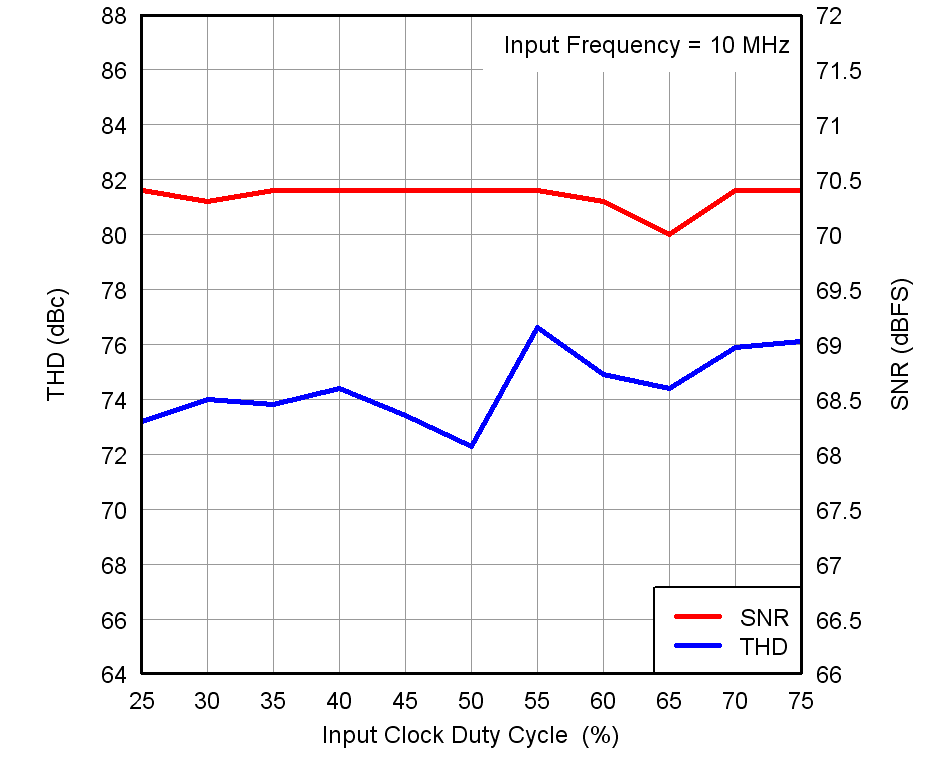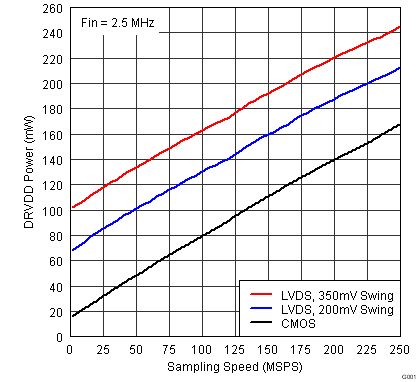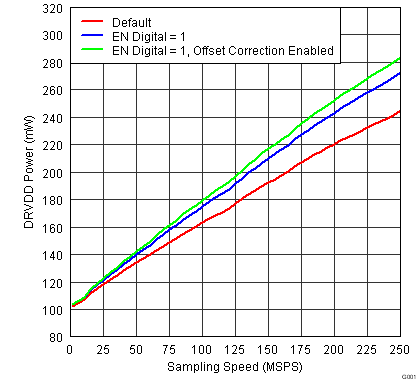-
ADS4229 Dual-Channel, 12-Bit, 250-MSPS Ultralow-Power ADC
- 1 Features
- 2 Applications
- 3 Description
- 4 Revision History
- 5 Device Comparison Table
- 6 Pin Configuration and Functions
-
7 Specifications
- 7.1 Absolute Maximum Ratings
- 7.2 ESD Ratings
- 7.3 Recommended Operating Conditions
- 7.4 Thermal Information
- 7.5 Electrical Characteristics: ADS4229 (250 MSPS)
- 7.6 Electrical Characteristics: General
- 7.7 Digital Characteristics
- 7.8 LVDS and CMOS Modes Timing Requirements
- 7.9 LVDS Timings at Lower Sampling Frequencies
- 7.10 CMOS Timings at Lower Sampling Frequencies
- 7.11 Serial Interface Timing Characteristics
- 7.12 Reset Timing (Only when Serial Interface is Used)
- 7.13 Typical Characteristics
-
8 Detailed Description
- 8.1 Overview
- 8.2 Functional Block Diagram
- 8.3 Feature Description
- 8.4 Device Functional Modes
- 8.5 Programming
- 8.6
Register Maps
- 8.6.1 Serial Register Map
- 8.6.2
Description of Serial Registers
- 8.6.2.1 Register Address 00h (Default = 00h)
- 8.6.2.2 Register Address 01h (Default = 00h)
- 8.6.2.3 Register Address 03h (Default = 00h)
- 8.6.2.4 Register Address 25h (Default = 00h)
- 8.6.2.5 Register Address 29h (Default = 00h)
- 8.6.2.6 Register Address 2Bh (Default = 00h)
- 8.6.2.7 Register Address 3Dh (Default = 00h)
- 8.6.2.8 Register Address 3Fh (Default = 00h)
- 8.6.2.9 Register Address 40h (Default = 00h)
- 8.6.2.10 Register Address 41h (Default = 00h)
- 8.6.2.11 Register Address 42h (Default = 00h)
- 8.6.2.12 Register Address 45h (Default = 00h)
- 8.6.2.13 Register Address 4Ah (Default = 00h)
- 8.6.2.14 Register Address 58h (Default = 00h)
- 8.6.2.15 Register Address BFh (Default = 00h)
- 8.6.2.16 Register Address C1h (Default = 00h)
- 8.6.2.17 Register Address CFh (Default = 00h)
- 8.6.2.18 Register Address EFh (Default = 00h)
- 8.6.2.19 Register Address F1h (Default = 00h)
- 8.6.2.20 Register Address F2h (Default = 00h)
- 8.6.2.21 Register Address 2h (Default = 00h)
- 8.6.2.22 Register Address D5h (Default = 00h)
- 8.6.2.23 Register Address D7h (Default = 00h)
- 8.6.2.24 Register Address DBh (Default = 00h)
- 9 Application and Implementation
- 10Power Supply Recommendations
- 11Layout
- 12Device and Documentation Support
- 13Mechanical, Packaging, and Orderable Information
- IMPORTANT NOTICE
Package Options
Mechanical Data (Package|Pins)
- RGC|64
Thermal pad, mechanical data (Package|Pins)
- RGC|64
Orderable Information
ADS4229 Dual-Channel, 12-Bit, 250-MSPS Ultralow-Power ADC
1 Features
- Maximum Sample Rate: 250 MSPS
- Ultralow Power with Single 1.8-V Supply:
- 545-mW Total Power at 250 MSPS
- High Dynamic Performance:
- Crosstalk: > 90 dB at 185 MHz
- Programmable Gain Up to 6 dB for
SNR and SFDR Trade-off - DC Offset Correction
- Output Interface Options:
- 1.8-V Parallel CMOS Interface
- DDR LVDS With Programmable Swing:
- Standard Swing: 350 mV
- Low Swing: 200 mV
- Supports Low Input Clock Amplitude
Down to 200 mVPP - Package: 9-mm × 9-mm, 64-Pin Quad Flat
No-Lead (QFN) Package
2 Applications
- Wireless Communications Infrastructure
- Software Defined Radio
- Power Amplifier Linearization
3 Description
The ADS4229 is a member of the ADS42xx ultralow-power family of dual-channel, 12-bit and 14-bit analog-to-digital converters (ADCs). Innovative design techniques are used to achieve high dynamic performance, while consuming extremely low power with a 1.8-V supply. This topology makes the ADS4229 well-suited for multi-carrier, wide-bandwidth communications applications.
The ADS4229 has gain options that can be used to improve spurious-free dynamic range (SFDR) performance at lower full-scale input ranges. This device also includes a dc offset correction loop that can be used to cancel the ADC offset. Both double data rate (DDR) low-voltage differential signaling (LVDS) and parallel complementary metal oxide semiconductor (CMOS) digital output interfaces are available in a compact QFN-64 PowerPAD™ package.
The device includes internal references while the traditional reference pins and associated decoupling capacitors have been eliminated. The ADS4229 is specified over the industrial temperature range (–40°C to +85°C).
Device Information(1)
| PART NUMBER | PACKAGE | BODY SIZE (NOM) |
|---|---|---|
| ADS4229 | VQFN (64) | 9.00 mm × 9.00 mm |
- For all available packages, see the orderable addendum at the end of the datasheet.
ADS4229 Block Diagram
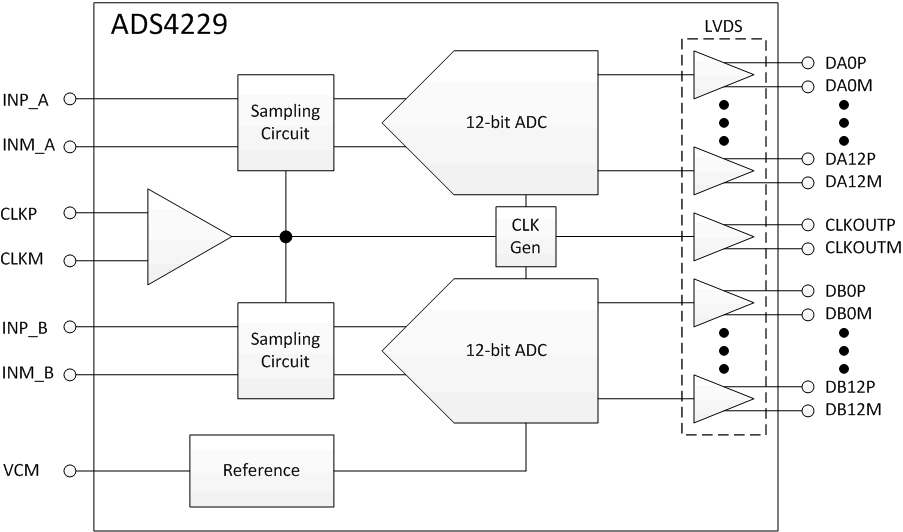
4 Revision History
Changes from B Revision (August 2012) to C Revision
- Added Pin Configuration and Functions section, ESD Rating table, Feature Description section, Device Functional Modes, Application and Implementation section, Power Supply Recommendations section, Layout section, Device and Documentation Support section, and Mechanical, Packaging, and Orderable Information section Go
Changes from A Revision (October 2011) to B Revision
- Changed first sub-bullet of High Dynamic Performance Features bulletGo
- Changed footnote 1 in CMOS Timings at Lower Sampling FrequenciesGo
- Changed row D5 and consolidated the two DB rows in Table 10Go
- Changed Register Address D5hGo
- Changed title of Register Address DBh, consolidated two DBh registers into oneGo
Changes from * Revision (June 2011) to A Revision
- Changed ADS4229 Input Common-Mode Voltage parameter in Table 1Go
- Changed AC power-supply rejection ratio parameter test condition in ADS4229 Electrical Characteristics tableGo
- Updated Figure 3Go
- Updated Figure 25Go
- Updated Figure 31Go
- Updated Figure 32Go
- Changed Time Constant, TCCLK × 1/fS (ms) column and footnote 1 in Table 3Go
- Changed Revised Channel Standby sectionGo
- Changed High-performance mode parameter description in High-Performance Modes tableGo
- Changed description of bits[7:2] in Register Address 40hGo
- Updated Register Address D7h and Register Address D8h tablesGo
- Updated first paragraph of Analog Input sectionGo
- Updated first paragraph of Driving Circuit subsectionGo
5 Device Comparison Table
The ADS4229 is pin-compatible with the previous generation ADS62P49 data converter; this similar architecture enables easy migration. However, there are some important differences between the two device generations, summarized in Table 1.
Table 1. Migrating from the ADS62P49
6 Pin Configuration and Functions


Pin Functions (LVDS Mode)
| PIN | I/O | DESCRIPTION | |
|---|---|---|---|
| NAME | NO. | ||
| AGND | 17 | I | Analog ground |
| 18 | |||
| 21 | |||
| 24 | |||
| 27 | |||
| 28 | |||
| 31 | |||
| 32 | |||
| AVDD | 16 | I | Analog power supply |
| 22 | |||
| 23 | |||
| 34 | |||
| CLKM | 26 | I | Differential clock negative input |
| CLKP | 25 | I | Differential clock positive input |
| CTRL1 | 35 | I | Digital control input pins. Together, they control the various power-down modes. |
| CTRL2 | 36 | I | Digital control input pins. Together, they control the various power-down modes. |
| CTRL3 | 37 | I | Digital control input pins. Together, they control the various power-down modes. |
| CLKOUTP | 57 | O | Differential output clock, true |
| CLKOUTM | 56 | O | Differential output clock, complement |
| DA0M | 42 | O | Channel A differential output data pair, D0 and D1 multiplexed |
| DA0P | 43 | ||
| DA2M | 44 | O | Channel A differential output data D2 and D3 multiplexed |
| DA2P | 45 | ||
| DA4M | 46 | O | Channel A differential output data D4 and D5 multiplexed |
| DA4P | 47 | ||
| DA6M | 50 | O | Channel A differential output data D6 and D7 multiplexed |
| DA6P | 51 | ||
| DA8M | 52 | O | Channel A differential output data D8 and D9 multiplexed |
| DA8P | 53 | ||
| DA10M | 54 | O | Channel A differential output data D10 and D11 multiplexed |
| DA10P | 55 | ||
| DB0M | 62 | O | Channel B differential output data pair, D0 and D1 multiplexed |
| DB0P | 63 | ||
| DB2M | 2 | O | Channel B differential output data D2 and D3 multiplexed |
| DB2P | 3 | ||
| DB4M | 4 | O | Channel B differential output data D4 and D5 multiplexed |
| DB4P | 5 | ||
| DB6M | 6 | O | Channel B differential output data D6 and D7 multiplexed |
| DB6P | 7 | ||
| DB8M | 8 | O | Channel B differential output data D8 and D9 multiplexed |
| DB8P | 9 | ||
| DB10M | 10 | O | Channel B differential output data D10 and D11 multiplexed |
| DB10P | 11 | ||
| DRGND | 49 | I | Output buffer ground |
| PAD | |||
| DRVDD | 1 | I | Output buffer supply |
| 48 | |||
| INP_A | 29 | I | Differential analog positive input, channel A |
| INM_A | 30 | I | Differential analog negative input, channel A |
| INP_B | 19 | I | Differential analog positive input, channel B |
| INM_B | 20 | I | Differential analog negative input, channel B |
| NC | 38 | — | Do not connect, must be floated |
| 39 | |||
| 40 | |||
| 41 | |||
| 58 | |||
| 59 | |||
| 60 | |||
| 61 | |||
| RESET | 12 | I | Serial interface RESET input. When using the serial interface mode, the internal registers must be initialized through a hardware RESET by applying a high pulse on this pin or by using the software reset option; refer to the Serial Interface Configuration section. In parallel interface mode, the RESET pin must be permanently tied high. SCLK and SEN are used as parallel control pins in this mode. This pin has an internal 150-kΩ pull-down resistor. |
| SCLK | 13 | I | This pin functions as a serial interface clock input when RESET is low. It controls the low-speed mode selection when RESET is tied high; see Table 7 for detailed information. This pin has an internal 150-kΩ pull-down resistor. |
| SDATA | 14 | I | Serial interface data input; this pin has an internal 150-kΩ pull-down resistor. |
| SDOUT | 64 | O | This pin functions as a serial interface register readout when the READOUT bit is enabled. When READOUT = 0, this pin is put into a high-impedance state. |
| VCM | 23 | O | This pin outputs the common-mode voltage (0.95 V) that can be used externally to bias the analog input pins |
Pin Functions (CMOS Mode)
| PIN | I/O | DESCRIPTION | |
|---|---|---|---|
| NAME | NO. | ||
| AGND | 17 | I | Analog ground |
| 18 | |||
| 21 | |||
| 24 | |||
| 27 | |||
| 28 | |||
| 31 | |||
| 32 | |||
| AVDD | 16 | I | Analog power supply |
| 22 | |||
| 33 | |||
| 34 | |||
| CLKM | 26 | I | Differential clock negative input |
| CLKOUT | 57 | O | CMOS output clock |
| CLKP | 25 | I | Differential clock positive input |
| CTRL1 | 35 | I | Digital control input pins. Together, they control various power-down modes. |
| CTRL2 | 36 | I | Digital control input pins. Together, they control various power-down modes. |
| CTRL3 | 37 | I | Digital control input pins. Together, they control various power-down modes. |
| DA0 | 42 | O | Channel A ADC output data bits, CMOS levels |
| DA1 | 43 | ||
| DA2 | 44 | ||
| DA3 | 45 | ||
| DA4 | 46 | ||
| DA5 | 47 | ||
| DA6 | 50 | ||
| DA7 | 51 | ||
| DA8 | 52 | ||
| DA9 | 53 | ||
| DA10 | 54 | ||
| DA11 | 55 | ||
| DB0 | 62 | O | Channel B ADC output data bits, CMOS levels |
| DB1 | 63 | ||
| DB2 | 2 | ||
| DB3 | 3 | ||
| DB4 | 4 | ||
| DB5 | 5 | ||
| DB6 | 6 | ||
| DB7 | 7 | ||
| DB8 | 8 | ||
| DB9 | 9 | ||
| DB10 | 10 | ||
| DB11 | 11 | ||
| DRGND | 49 | I | Output buffer ground |
| PAD | |||
| DRVDD | 1 | I | Output buffer supply |
| 48 | |||
| NC | — | — | Do not connect, must be floated |
| RESET | 12 | I | Serial interface RESET input. When using the serial interface mode, the internal registers must be initialized through a hardware RESET by applying a high pulse on this pin or by using the software reset option; refer to the Serial Interface Configuration section. In parallel interface mode, the RESET pin must be permanently tied high. SDATA and SEN are used as parallel control pins in this mode. This pin has an internal 150-kΩ pull-down resistor. |
| INM_A | 30 | I | Differential analog negative input, channel A |
| INP_A | 29 | I | Differential analog positive input, channel A |
| INM_B | 20 | I | Differential analog negative input, channel B |
| INP_B | 19 | I | Differential analog positive input, channel B |
| SCLK | 13 | I | This pin functions as a serial interface clock input when RESET is low. It controls the low-speed mode when RESET is tied high; see Table 7 for detailed information. This pin has an internal 150-kΩ pull-down resistor. |
| SDATA | 14 | I | Serial interface data input; this pin has an internal 150-kΩ pull-down resistor. |
| SDOUT | 64 | O | This pin functions as a serial interface register readout when the READOUT bit is enabled. When READOUT = 0, this pin is put into a high-impedance state. |
| SEN | 15 | I | This pin functions as a serial interface enable input when RESET is low. It controls the output interface and data format selection when RESET is tied high; see Table 8 for detailed information. This pin has an internal 150-kΩ pull-up resistor to AVDD. |
| VCM | 23 | O | This pin outputs the common-mode voltage (0.95 V) that can be used externally to bias the analog input pins |
| UNUSED | 56 | — | This pin is not used in the CMOS interface |
7 Specifications
7.1 Absolute Maximum Ratings(1)
| MIN | MAX | UNIT | ||
|---|---|---|---|---|
| Supply voltage, AVDD | –0.3 | 2.1 | V | |
| Supply voltage, DRVDD | –0.3 | 2.1 | V | |
| Voltage between AGND and DRGND | –0.3 | 0.3 | V | |
| Voltage between AVDD to DRVDD (when AVDD leads DRVDD) | –2.4 | 2.4 | V | |
| Voltage between DRVDD to AVDD (when DRVDD leads AVDD) | –2.4 | 2.4 | V | |
| Voltage applied to input pins | INP_A, INM_A, INP_B, INM_B | –0.3 | Minimum (1.9, AVDD + 0.3) |
V |
| CLKP, CLKM(2) | –0.3 | AVDD + 0.3 | V | |
| RESET, SCLK, SDATA, SEN, CTRL1, CTRL2, CTRL3 |
–0.3 | 3.9 | V | |
| Operating free-air temperature, TA | –40 | 85 | °C | |
| Operating junction temperature, TJ | 125 | °C | ||
| Storage temperature, Tstg | –65 | 150 | °C | |
7.2 ESD Ratings
| VALUE | UNIT | |||
|---|---|---|---|---|
| V(ESD) | Electrostatic discharge | Human body model (HBM), per ANSI/ESDA/JEDEC JS-001(1) | 2000 | V |
7.3 Recommended Operating Conditions
Over operating free-air temperature range, unless otherwise noted.| MIN | NOM | MAX | UNIT | ||
|---|---|---|---|---|---|
| SUPPLIES | |||||
| Analog supply voltage, AVDD | 1.7 | 1.8 | 1.9 | V | |
| Digital supply voltage, DRVDD | 1.7 | 1.8 | 1.9 | V | |
| ANALOG INPUTS | |||||
| Differential input voltage range | 2 | VPP | |||
| Input common-mode voltage | VCM ± 0.05 | V | |||
| Maximum analog input frequency with 2-VPP input amplitude(1) | 400 | MHz | |||
| Maximum analog input frequency with 1-VPP input amplitude(1) | 600 | MHz | |||
| CLOCK INPUT | |||||
| Input clock sample rate | |||||
| Low-speed mode enabled(2) | 1 | 80 | MSPS | ||
| Low-speed mode disabled(2) (by default after reset) | 80 | 250 | MSPS | ||
| Input clock amplitude differential (VCLKP – VCLKM) |
Sine wave, ac-coupled | 0.2 | 1.5 | VPP | |
| LVPECL, ac-coupled | 1.6 | VPP | |||
| LVDS, ac-coupled | 0.7 | VPP | |||
| LVCMOS, single-ended, ac-coupled | 1.5 | V | |||
| Input clock duty cycle | |||||
| Low-speed mode disabled | 35% | 50% | 65% | ||
| Low-speed mode enabled | 40% | 50% | 60% | ||
| DIGITAL OUTPUTS | |||||
| Maximum external load capacitance from each output pin to DRGND, CLOAD | 5 | pF | |||
| Differential load resistance between the LVDS output pairs (LVDS mode), RLOAD | 100 | Ω | |||
| Operating free-air temperature, TA | –40 | +85 | °C | ||
7.4 Thermal Information
| THERMAL METRIC(1) | ADS4229 | UNIT | |
|---|---|---|---|
| RGC (VQFN) | |||
| 64 PINS | |||
| RθJA | Junction-to-ambient thermal resistance | 23.9 | °C/W |
| RθJC(top) | Junction-to-case (top) thermal resistance | 10.9 | °C/W |
| RθJB | Junction-to-board thermal resistance | 4.3 | °C/W |
| ψJT | Junction-to-top characterization parameter | 0.1 | °C/W |
| ψJB | Junction-to-board characterization parameter | 4.4 | °C/W |
| RθJC(bot) | Junction-to-case (bottom) thermal resistance | 0.6 | °C/W |
7.5 Electrical Characteristics: ADS4229 (250 MSPS)
Typical values are at +25°C, AVDD = 1.8 V, DRVDD = 1.8 V, 50% clock duty cycle, –1 dBFS differential analog input, LVDS interface, and 0-dB gain, unless otherwise noted. Minimum and maximum values are across the full temperature range:TMIN = –40°C to TMAX = +85°C, AVDD = 1.8 V, and DRVDD = 1.8 V.
7.6 Electrical Characteristics: General
Typical values are at +25°C, AVDD = 1.8 V, DRVDD = 1.8 V, 50% clock duty cycle, and –1 dBFS differential analog input, unless otherwise noted. Minimum and maximum values are across the full temperature range: TMIN = –40°C to TMAX = +85°C, AVDD = 1.8 V, and DRVDD = 1.8 V.| PARAMETER | MIN | TYP | MAX | UNIT | |
|---|---|---|---|---|---|
| ANALOG INPUTS | |||||
| Differential input voltage range | 2 | VPP | |||
| Differential input resistance (at 200 MHz) | 0.75 | kΩ | |||
| Differential input capacitance (at 200 MHz) | 3.7 | pF | |||
| Analog input bandwidth (with 50-Ω source impedance, and 50-Ω termination) |
550 | MHz | |||
| Analog input common-mode current (per input pin of each channel) |
1.5 | µA/MSPS | |||
| Common-mode output voltage | VCM | 0.95(2) | V | ||
| VCM output current capability | 4 | mA | |||
| DC ACCURACY | |||||
| Offset error | –15 | 2.5 | 15 | mV | |
| Temperature coefficient of offset error | 0.003 | mV/°C | |||
| Gain error as a result of internal reference inaccuracy alone | EGREF | –2 | 2 | %FS | |
| Gain error of channel alone | EGCHAN | ±0.1 | 1 | %FS | |
| Temperature coefficient of EGCHAN | 0.002 | Δ%/°C | |||
| POWER SUPPLY | |||||
| IAVDD Analog supply current |
167 | 190 | mA | ||
| IDRVDD Output buffer supply current LVDS interface, 350-mV swing with 100-Ω external termination, fIN = 2.5 MHz |
136 | 160 | mA | ||
| IDRVDD Output buffer supply current CMOS interface, no load capacitance, fIN = 2.5 MHz(1) |
94 | mA | |||
| Analog power | 301 | mW | |||
| Digital power LVDS interface, 350-mV swing with 100-Ω external termination, fIN = 2.5 MHz |
245 | mW | |||
| Digital power CMOS interface, 8-pF external load capacitance(1) fIN = 2.5 MHz |
169 | mW | |||
| Global power-down | 25 | mW | |||
7.7 Digital Characteristics
At AVDD = 1.8 V and DRVDD = 1.8 V, unless otherwise noted. DC specifications refer to the condition where the digital outputs do not switch, but are permanently at a valid logic level '0' or '1'.| PARAMETER | TEST CONDITIONS | MIN | TYP | MAX | UNIT | |
|---|---|---|---|---|---|---|
| DIGITAL INPUTS (RESET, SCLK, SDATA, SEN, CTRL1, CTRL2, CTRL3)(1) | ||||||
| High-level input voltage | All digital inputs support 1.8-V and 3.3-V CMOS logic levels | 1.3 | V | |||
| Low-level input voltage | 0.4 | V | ||||
| High-level input current | SDATA, SCLK(2) | VHIGH = 1.8 V | 10 | µA | ||
| SEN(3) | VHIGH = 1.8 V | 0 | µA | |||
| Low-level input current | SDATA, SCLK | VLOW = 0 V | 0 | µA | ||
| SEN | VLOW = 0 V | 10 | µA | |||
| DIGITAL OUTPUTS, CMOS INTERFACE (DA[13:0], DB[13:0], CLKOUT, SDOUT) | ||||||
| High-level output voltage | DRVDD – 0.1 | DRVDD | V | |||
| Low-level output voltage | 0 | 0.1 | V | |||
| Output capacitance (internal to device) | pF | |||||
| DIGITAL OUTPUTS, LVDS INTERFACE | ||||||
| High-level output differential voltage |
VODH | With an external 100-Ω termination |
270 | 350 | 430 | mV |
| Low-level output differential voltage |
VODL | With an external 100-Ω termination |
–430 | –350 | –270 | mV |
| Output common-mode voltage | VOCM | 0.9 | 1.05 | 1.25 | V | |

7.8 LVDS and CMOS Modes Timing Requirements(1)
Typical values are at +25°C, AVDD = 1.8 V, DRVDD = 1.8 V, sampling frequency = 250 MSPS, sine wave input clock, CLOAD = 5 pF, and RLOAD = 100 Ω, unless otherwise noted. Minimum and maximum values are across the full temperature range: TMIN = –40°C to TMAX = +85°C, AVDD = 1.8 V, and DRVDD = 1.7 V to 1.9 V.| PARAMETER | DESCRIPTION | MIN | TYP | MAX | UNIT | |
|---|---|---|---|---|---|---|
| tA | Aperture delay | 0.5 | 0.8 | 1.1 | ns | |
| Aperture delay matching | Between the two channels of the same device | ±70 | ps | |||
| Variation of aperture delay | Between two devices at the same temperature and DRVDD supply | ±150 | ps | |||
| tJ | Aperture jitter | 140 | fS rms | |||
| Wakeup time | Time to valid data after coming out of STANDBY mode | 50 | 100 | µs | ||
| Time to valid data after coming out of GLOBAL power-down mode | 100 | 500 | µs | |||
| ADC latency(4) | Default latency after reset | 16 | Clock cycles | |||
| Digital functions enabled (EN DIGITAL = 1) | 24 | Clock cycles | ||||
| DDR LVDS MODE(2) | ||||||
| tSU | Data setup time | Data valid(3) to zero-crossing of CLKOUTP | 0.6 | 0.88 | ns | |
| tH | Data hold time | Zero-crossing of CLKOUTP to data becoming invalid(3) | 0.33 | 0.55 | ns | |
| tPDI | Clock propagation delay | Input clock rising edge cross-over to output clock rising edge cross-over | 5 | 6 | 7.5 | ns |
| LVDS bit clock duty cycle | Duty cycle of differential clock, (CLKOUTP-CLKOUTM) | 48% | ||||
| tRISE, tFALL |
Data rise time, Data fall time |
Rise time measured from –100 mV to +100 mV Fall time measured from +100 mV to –100 mV 1 MSPS ≤ Sampling frequency ≤ 250 MSPS |
0.13 | ns | ||
| tCLKRISE, tCLKFALL |
Output clock rise time, Output clock fall time |
Rise time measured from –100 mV to +100 mV Fall time measured from +100 mV to –100 mV 1 MSPS ≤ Sampling frequency ≤ 250 MSPS |
0.13 | ns | ||
| PARALLEL CMOS MODE | ||||||
| tPDI | Clock propagation delay | Input clock rising edge cross-over to output clock rising edge cross-over | 4.5 | 6.2 | 8.5 | ns |
| Output clock duty cycle | Duty cycle of output clock, CLKOUT 1 MSPS ≤ Sampling frequency ≤ 200 MSPS |
50% | ||||
| tRISE, tFALL |
Data rise time, Data fall time |
Rise time measured from 20% to 80% of DRVDD Fall time measured from 80% to 20% of DRVDD 1 MSPS ≤ Sampling frequency ≤ 200 MSPS |
0.7 | ns | ||
| tCLKRISE, tCLKFALL |
Output clock rise time Output clock fall time |
Rise time measured from 20% to 80% of DRVDD Fall time measured from 80% to 20% of DRVDD 1 MSPS ≤ Sampling frequency ≤ 200 MSPS |
0.7 | ns | ||
7.9 LVDS Timings at Lower Sampling Frequencies
Typical values are at +25°C, AVDD = 1.8 V, DRVDD = 1.8 V, sampling frequency = 250 MSPS, sine wave input clock, CLOAD = 5 pF, and RLOAD = 100 Ω, unless otherwise noted. Minimum and maximum values are across the full temperature range: TMIN = –40°C to TMAX = +85°C, AVDD = 1.8 V, and DRVDD = 1.7 V to 1.9 V.| SAMPLING FREQUENCY (MSPS) | SETUP TIME (ns) | HOLD TIME (ns) | tPDI, CLOCK PROPAGATION DELAY (ns) |
||||||
|---|---|---|---|---|---|---|---|---|---|
| MIN | TYP | MAX | MIN | TYP | MAX | MIN | TYP | MAX | |
| 65 | 5.9 | 6.6 | 0.35 | 0.6 | 5 | 6 | 7.5 | ||
| 80 | 4.5 | 5.2 | 0.35 | 0.6 | 5 | 6 | 7.5 | ||
| 125 | 2.3 | 2.9 | 0.35 | 0.6 | 5 | 6 | 7.5 | ||
| 160 | 1.5 | 2 | 0.33 | 0.55 | 5 | 6 | 7.5 | ||
| 185 | 1.3 | 1.6 | 0.33 | 0.55 | 5 | 6 | 7.5 | ||
| 200 | 1.1 | 1.4 | 0.33 | 0.55 | 5 | 6 | 7.5 | ||
| 230 | 0.76 | 1.06 | 0.33 | 0.55 | 5 | 6 | 7.5 | ||
7.10 CMOS Timings at Lower Sampling Frequencies
Typical values are at +25°C, AVDD = 1.8 V, DRVDD = 1.8 V, sampling frequency = 250 MSPS, sine wave input clock, CLOAD = 5 pF, and RLOAD = 100 Ω, unless otherwise noted. Minimum and maximum values are across the full temperature range: TMIN = –40°C to TMAX = +85°C, AVDD = 1.8 V, and DRVDD = 1.7 V to 1.9 V.| SAMPLING FREQUENCY (MSPS) | TIMINGS SPECIFIED WITH RESPECT TO CLKOUT | ||||||||
|---|---|---|---|---|---|---|---|---|---|
| SETUP TIME(1) (ns) | HOLD TIME(1) (ns) | tPDI, CLOCK PROPAGATION DELAY (ns) |
|||||||
| MIN | TYP | MAX | MIN | TYP | MAX | MIN | TYP | MAX | |
| 65 | 6.1 | 6.7 | 6.7 | 7.5 | 4.5 | 6.2 | 8.5 | ||
| 80 | 4.7 | 5.2 | 5.3 | 6 | 4.5 | 6.2 | 8.5 | ||
| 125 | 2.7 | 3.1 | 3.1 | 3.6 | 4.5 | 6.2 | 8.5 | ||
| 160 | 1.6 | 2.1 | 2.3 | 2.8 | 4.5 | 6.2 | 8.5 | ||
| 185 | 1.1 | 1.6 | 1.9 | 2.4 | 4.5 | 6.2 | 8.5 | ||
| 200 | 1 | 1.4 | 1.7 | 2.2 | 4.5 | 6.2 | 8.5 | ||
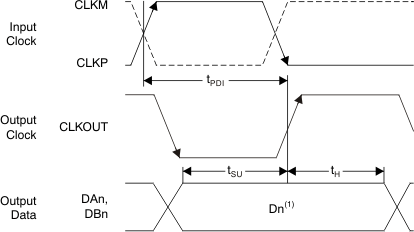
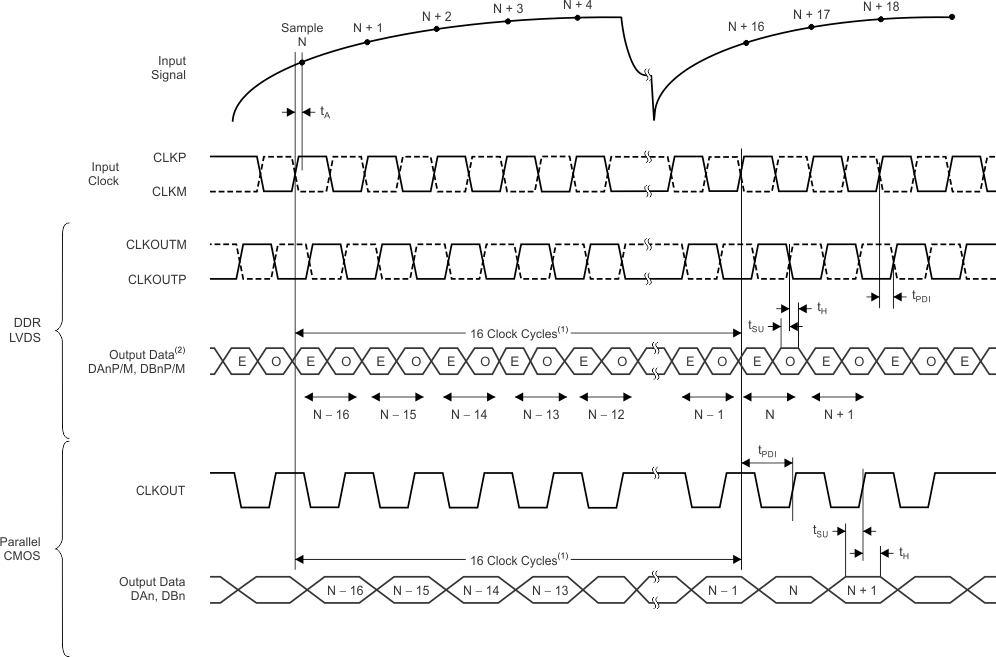
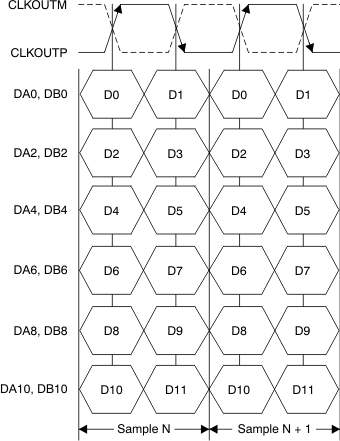 Figure 4. LVDS Interface Timing Diagram
Figure 4. LVDS Interface Timing Diagram
7.11 Serial Interface Timing Characteristics
See (1).| PARAMETER | MIN | TYP | MAX | UNIT | |
|---|---|---|---|---|---|
| fSCLK | SCLK frequency (equal to 1/tSCLK) | > DC | 20 | MHz | |
| tSLOADS | SEN to SCLK setup time | 25 | ns | ||
| tSLOADH | SCLK to SEN hold time | 25 | ns | ||
| tDSU | SDATA setup time | 25 | ns | ||
| tDH | SDATA hold time | 25 | ns | ||
AVDD = 1.8 V, and DRVDD = 1.8 V, unless otherwise noted.
 Figure 5. Serial Interface Timing Diagram
Figure 5. Serial Interface Timing Diagram
7.12 Reset Timing (Only when Serial Interface is Used)
See (1).| PARAMETER | TEST CONDITIONS | MIN | TYP | MAX | UNIT | |
|---|---|---|---|---|---|---|
| t1 | Power-on delay | Delay from AVDD and DRVDD power-up to active RESET pulse | 1 | ms | ||
| t2 | Reset pulse width | Active RESET signal pulse width | 10 | ns | ||
| 1 | µs | |||||
| t3 | Register write delay | Delay from RESET disable to SEN active | 100 | ns | ||
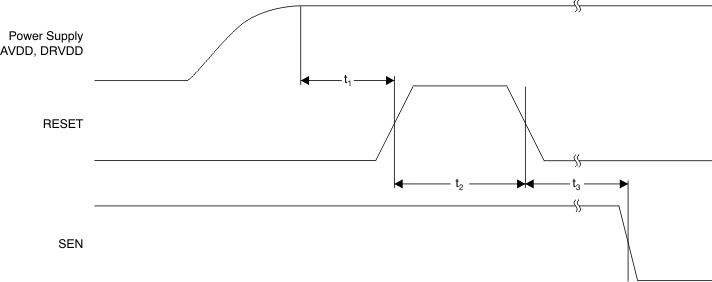
7.13 Typical Characteristics
7.13.1 Typical Characteristics: ADS4229
At TA = +25°C, AVDD = 1.8 V, DRVDD = 1.8 V, maximum rated sampling frequency, sine wave input clock, 1.5 VPP differential clock amplitude, 50% clock duty cycle, –1-dBFS differential analog input, High-Performance Mode enabled, 0-dB gain, DDR LVDS output interface, and 32k point FFT, unless otherwise noted.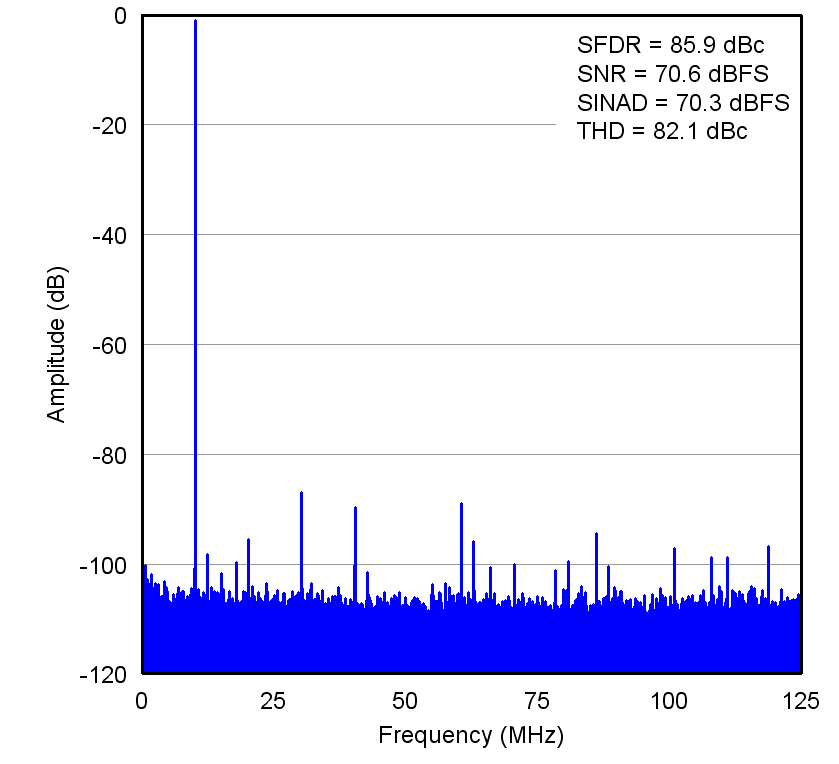 Figure 7. Input Signal (10 MHz)
Figure 7. Input Signal (10 MHz)
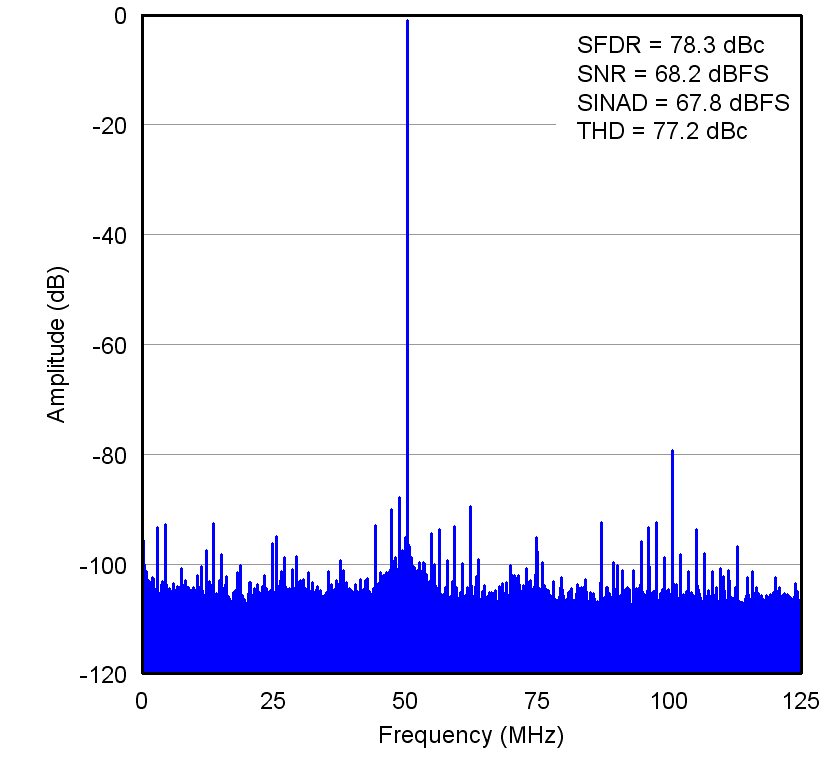 Figure 9. Input Signal (300 MHz)
Figure 9. Input Signal (300 MHz)
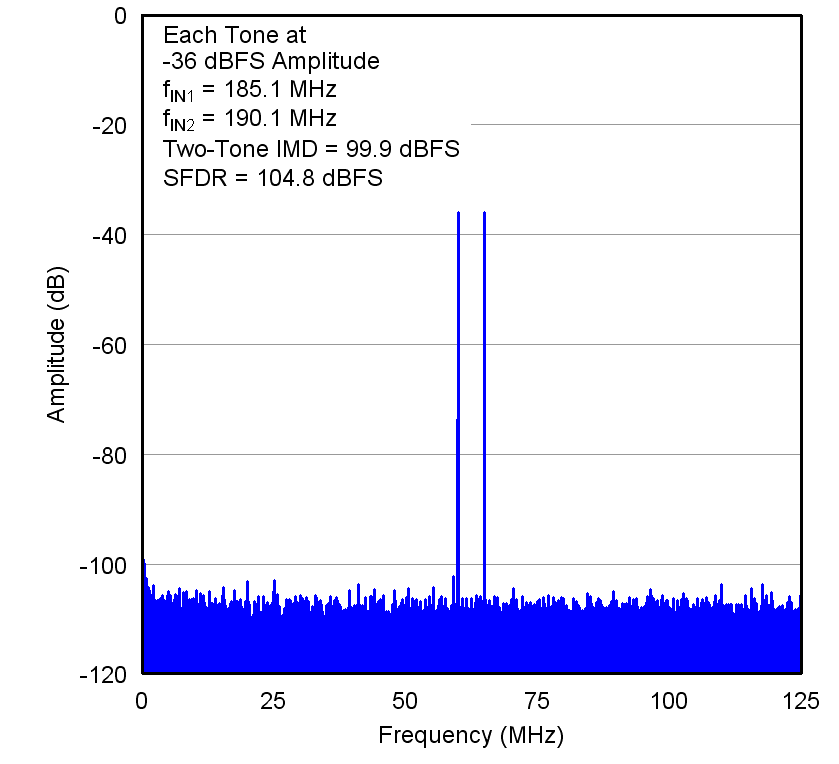 Figure 11. Two-Tone Input Signal
Figure 11. Two-Tone Input Signal
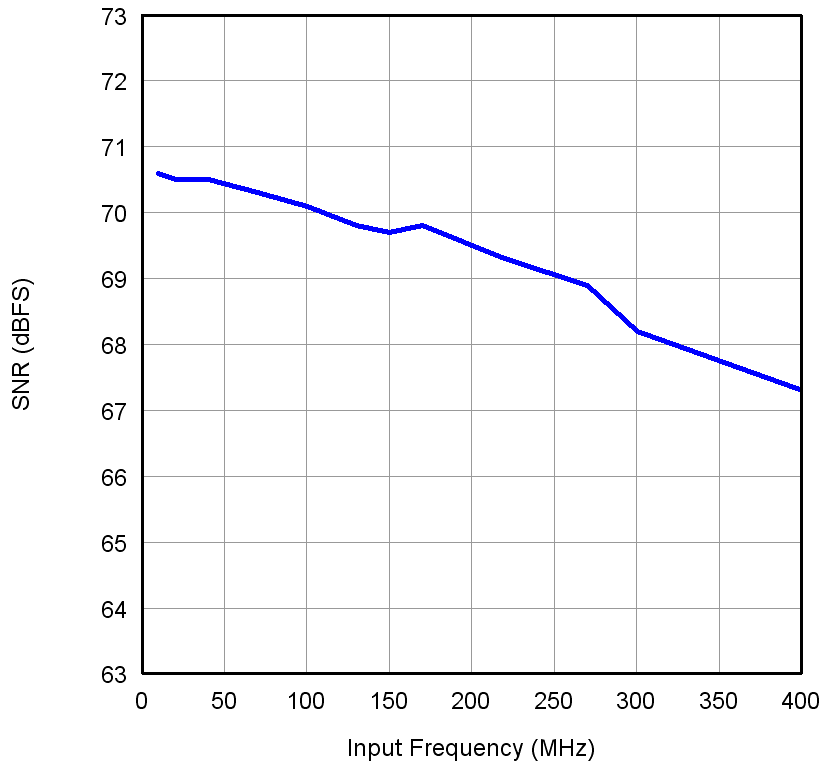 Figure 13. SNR vs Input Frequency
Figure 13. SNR vs Input Frequency
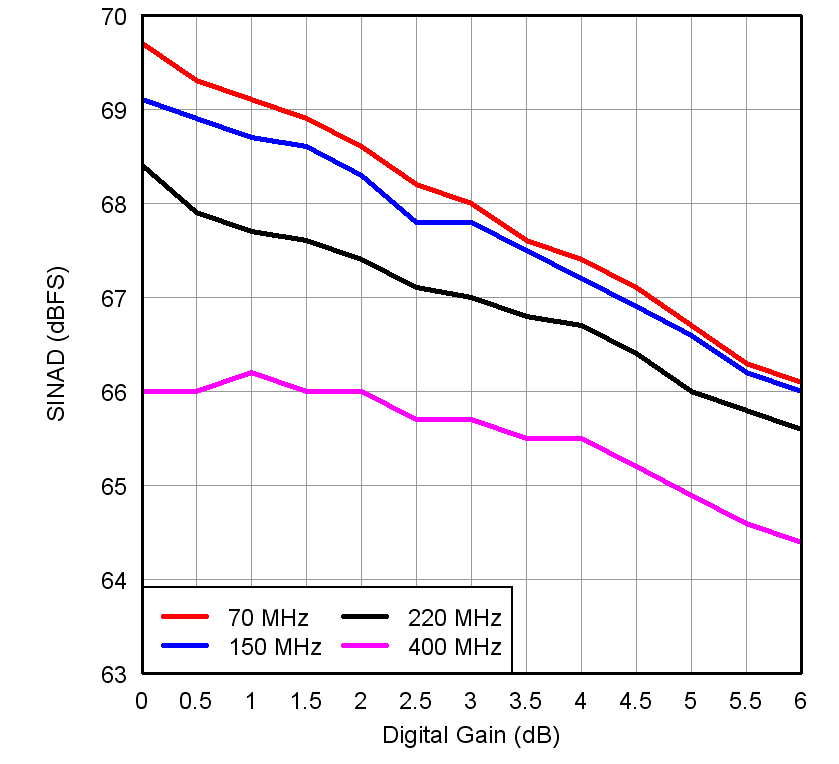 Figure 15. SINAD vs Gain and Input Frequency
Figure 15. SINAD vs Gain and Input Frequency
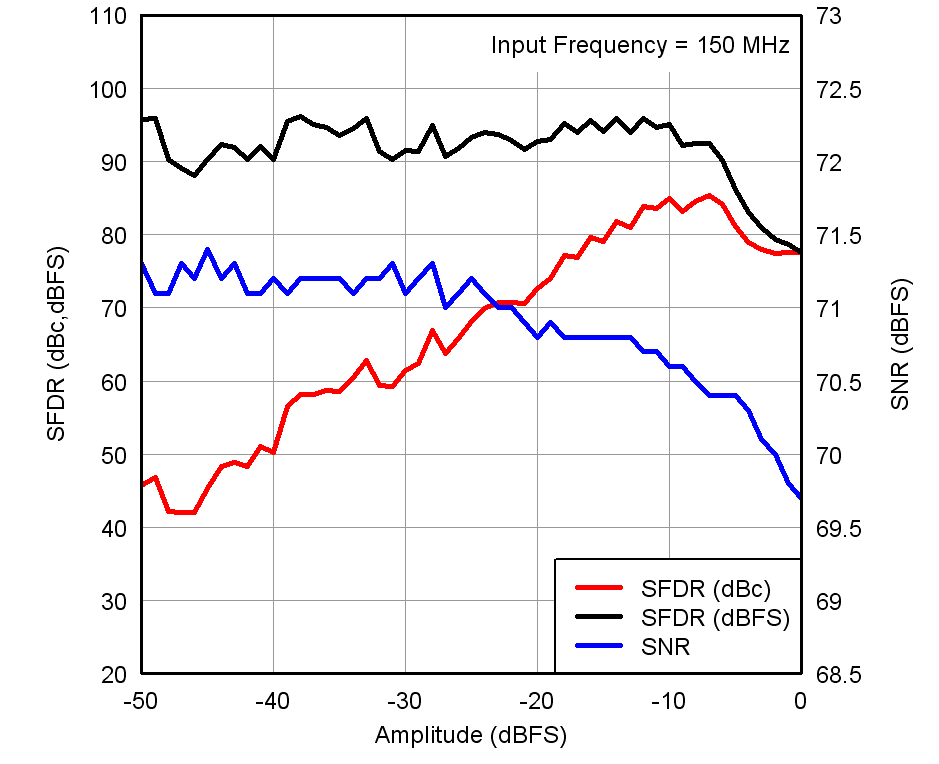 Figure 17. Performance vs Input Amplitude
Figure 17. Performance vs Input Amplitude
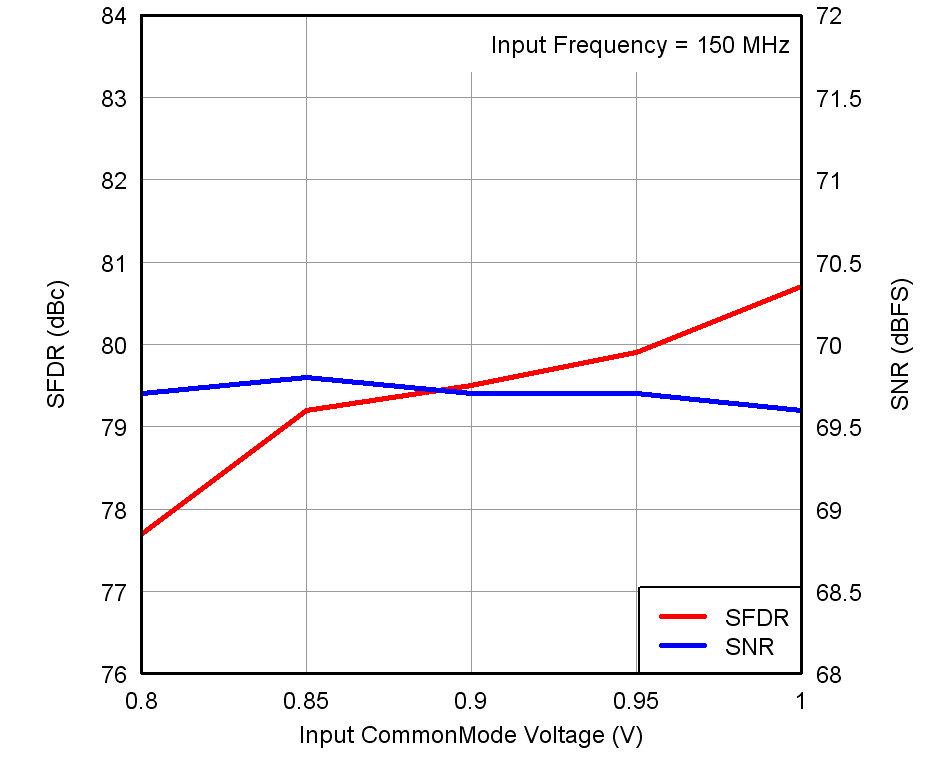 Figure 19. Performance vs Input Common-Mode Voltage
Figure 19. Performance vs Input Common-Mode Voltage
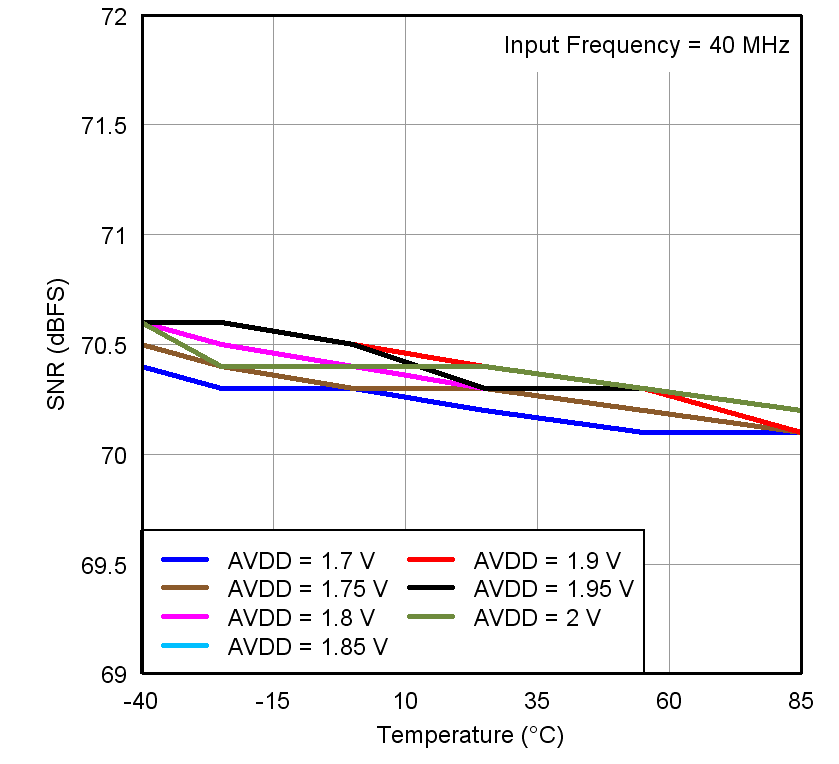 Figure 21. SNR vs Temperature and AVDD Supply
Figure 21. SNR vs Temperature and AVDD Supply
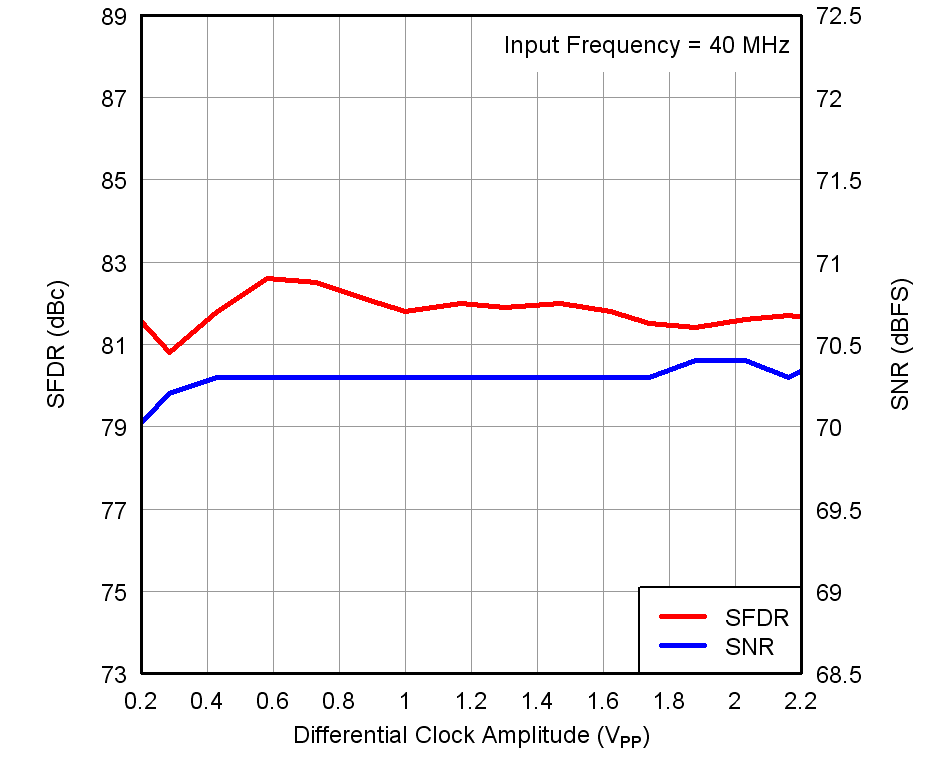 Figure 23. Performance vs Input Clock Amplitude
Figure 23. Performance vs Input Clock Amplitude
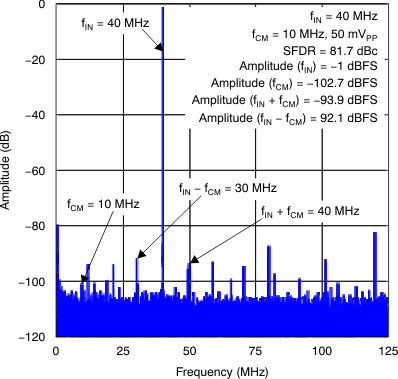 Figure 27. CMRR Plot
Figure 27. CMRR Plot
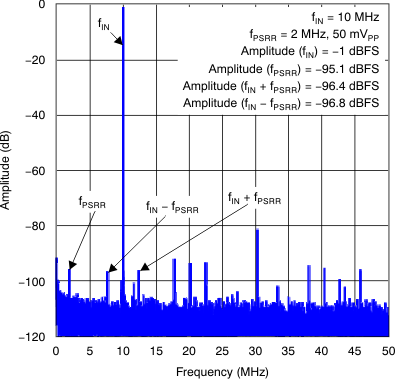 Figure 29. PSRR Plot
Figure 29. PSRR Plot
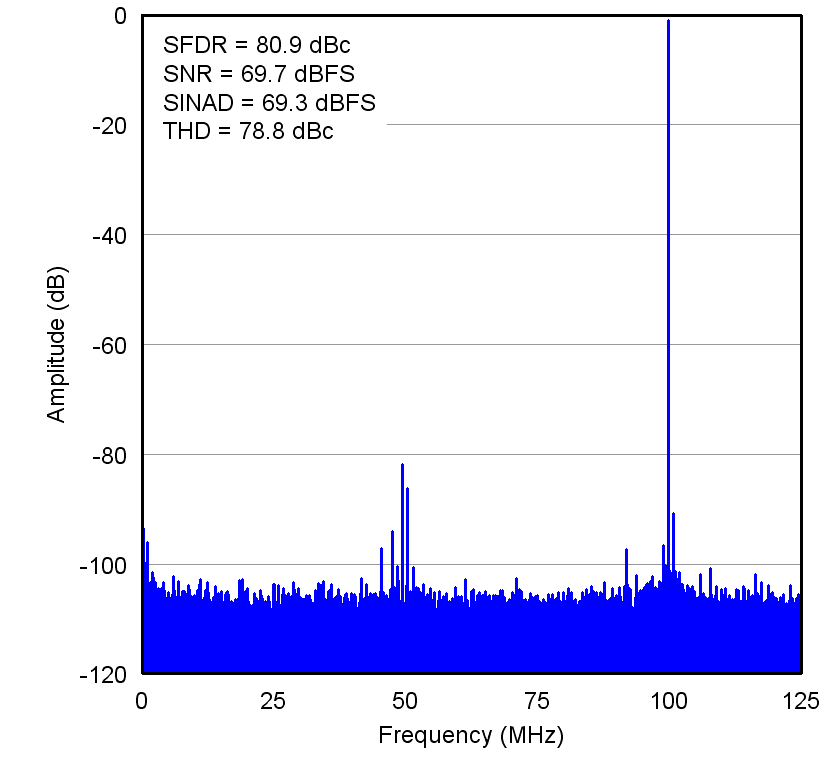 Figure 8. Input Signal (150 MHz)
Figure 8. Input Signal (150 MHz)
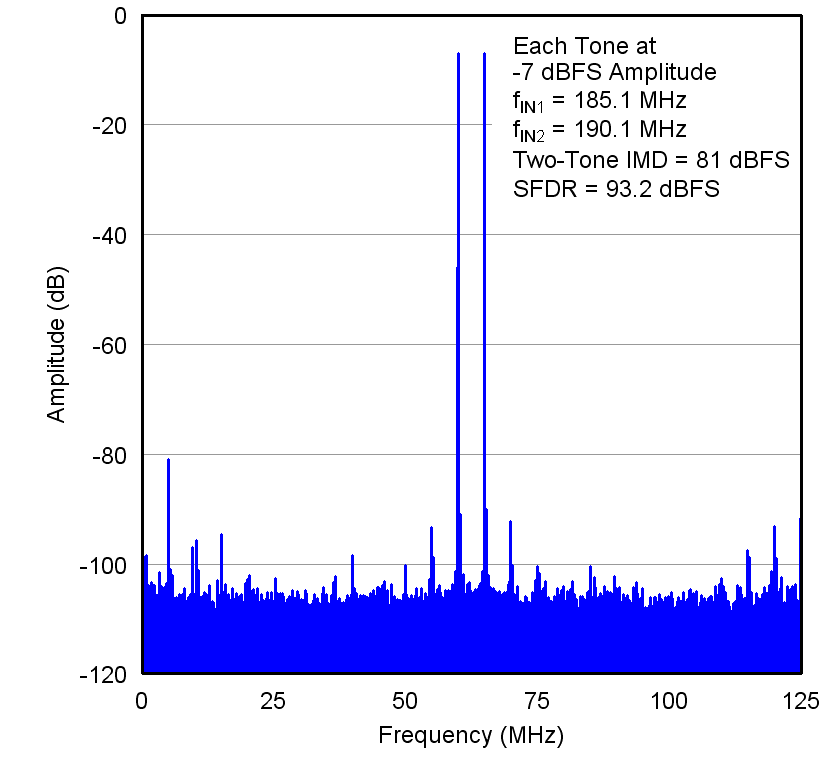 Figure 10. Two-Tone Input Signal
Figure 10. Two-Tone Input Signal
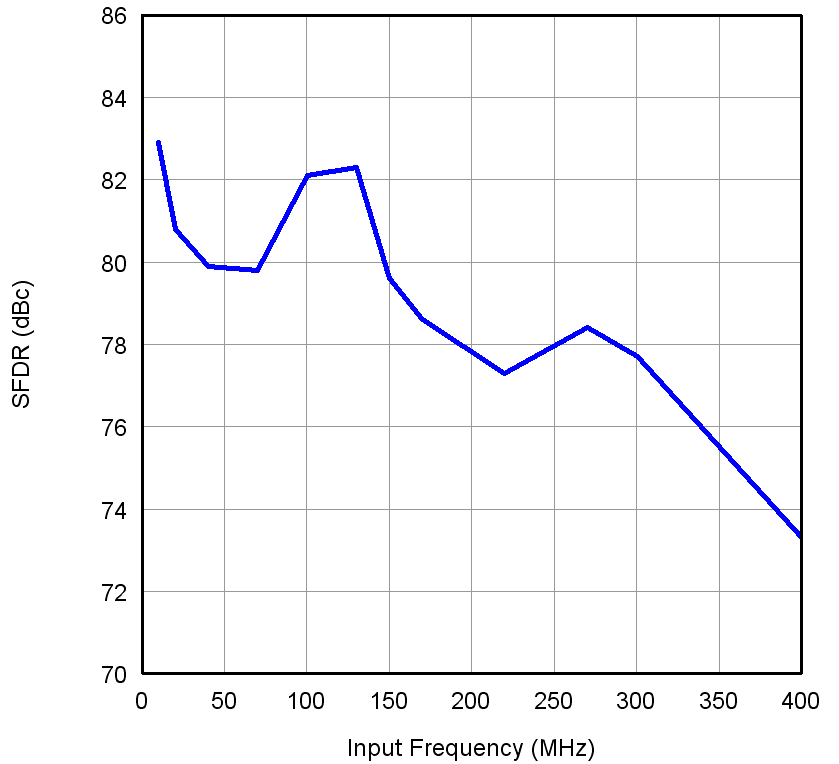 Figure 12. SFDR vs Input Frequency
Figure 12. SFDR vs Input Frequency
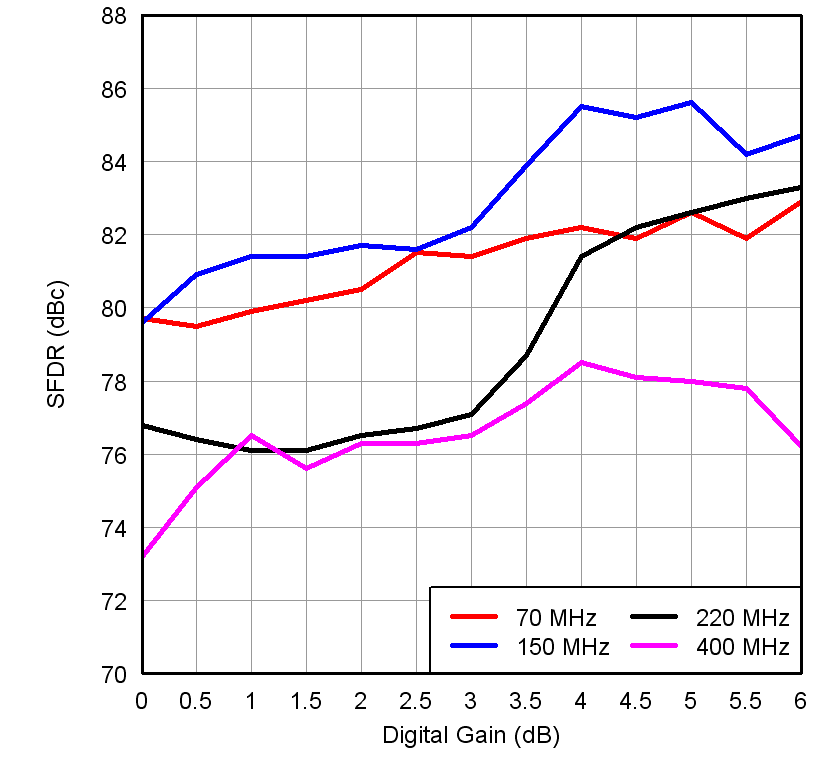 Figure 14. SFDR vs Gain and Input Frequency
Figure 14. SFDR vs Gain and Input Frequency
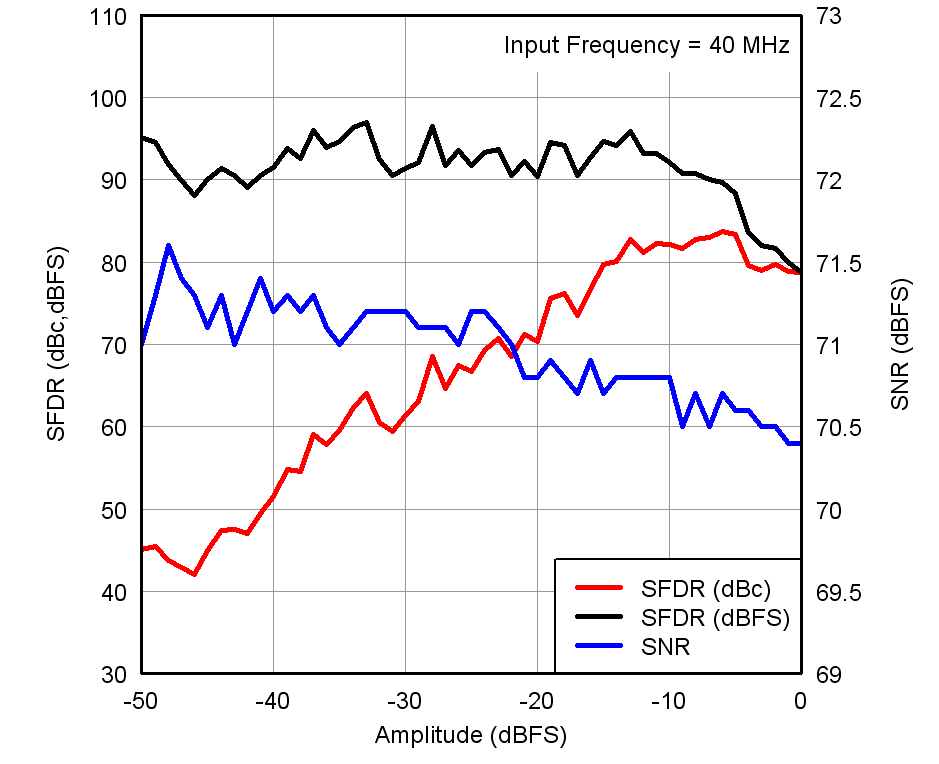 Figure 16. Performance vs Input Amplitude
Figure 16. Performance vs Input Amplitude
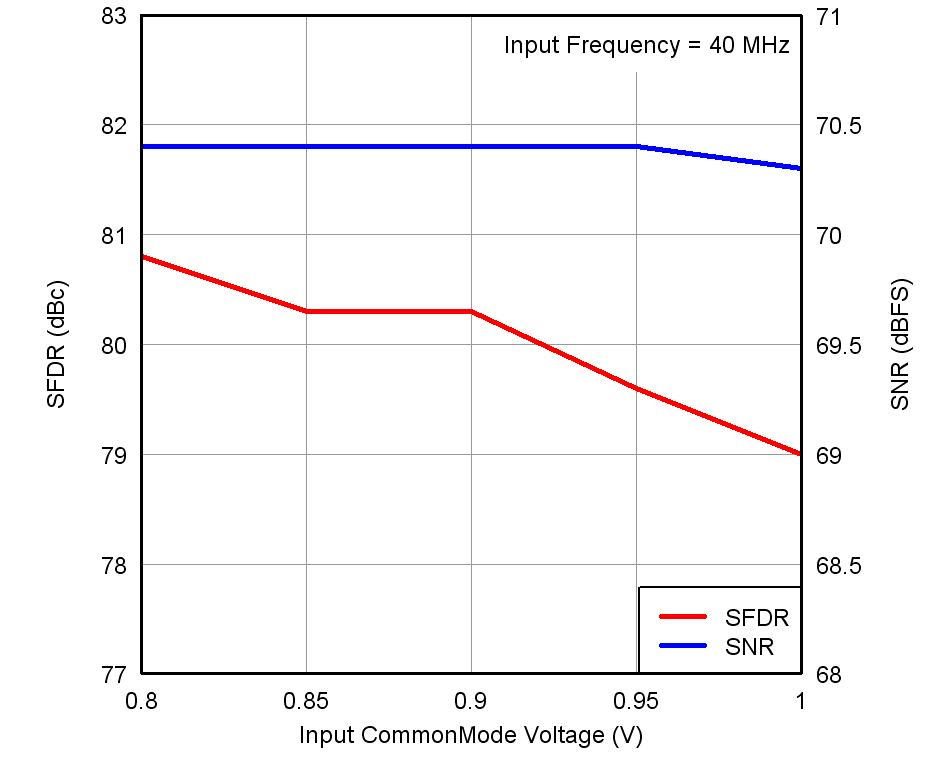 Figure 18. Performance vs Input Common-Mode Voltage
Figure 18. Performance vs Input Common-Mode Voltage
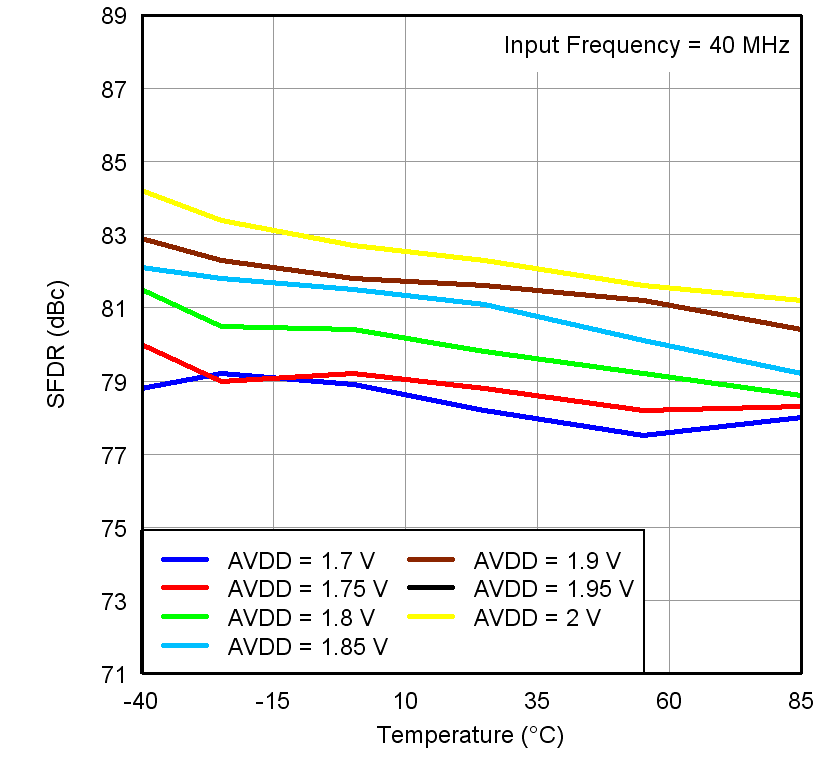 Figure 20. SFDR vs Temperature and AVDD Supply
Figure 20. SFDR vs Temperature and AVDD Supply
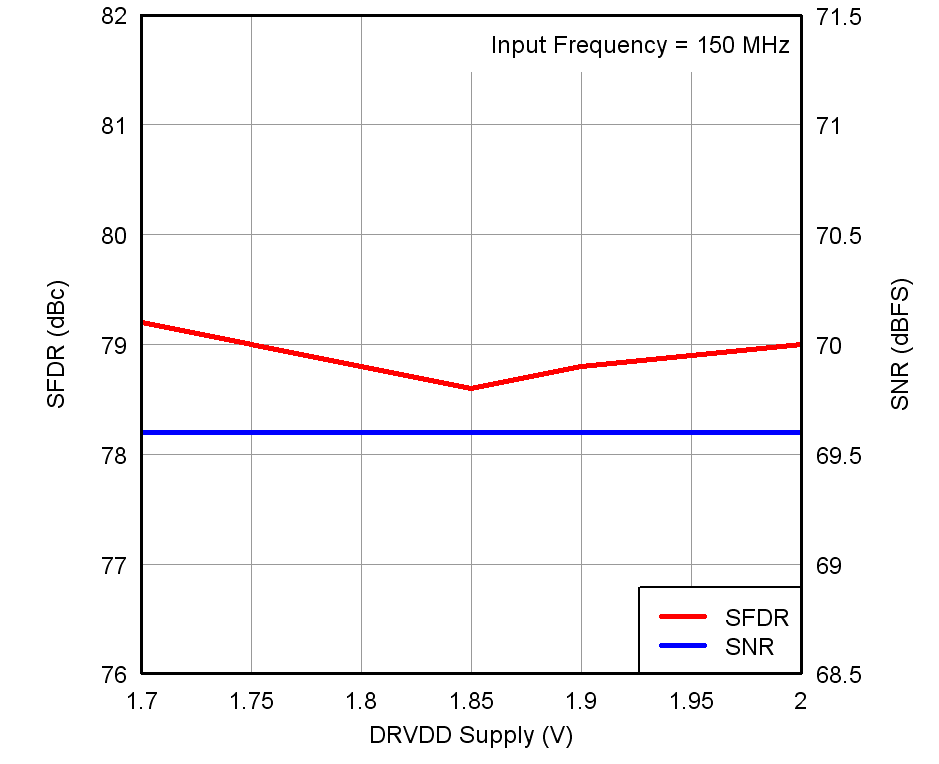 Figure 22. Performance vs DRVDD Supply Voltage
Figure 22. Performance vs DRVDD Supply Voltage
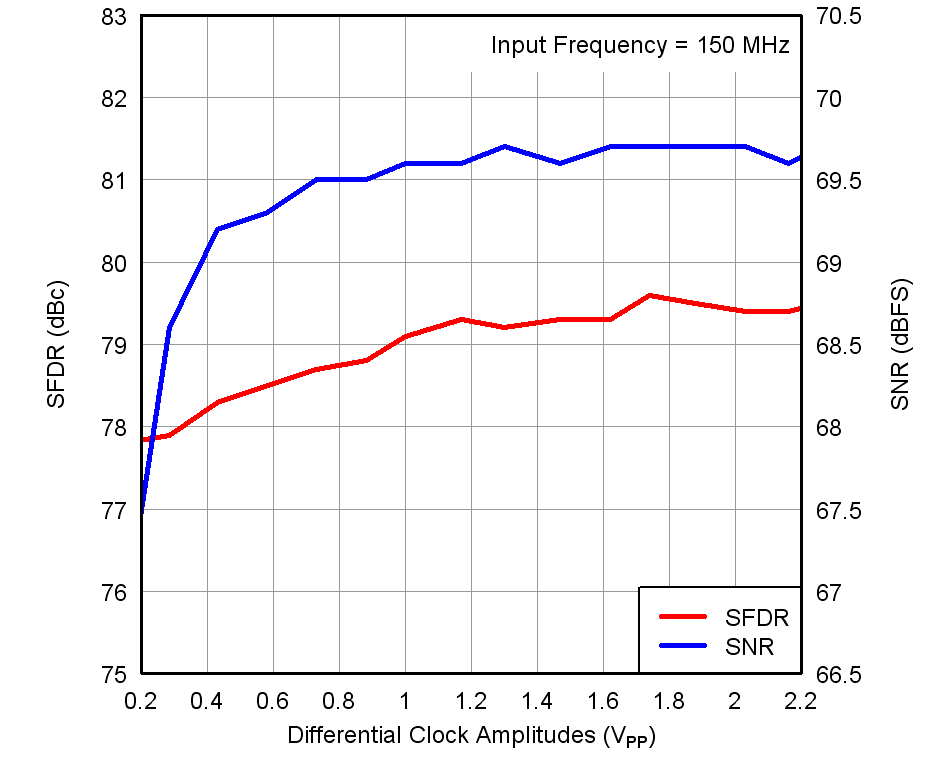 Figure 24. Performance vs Input Clock Amplitude
Figure 24. Performance vs Input Clock Amplitude
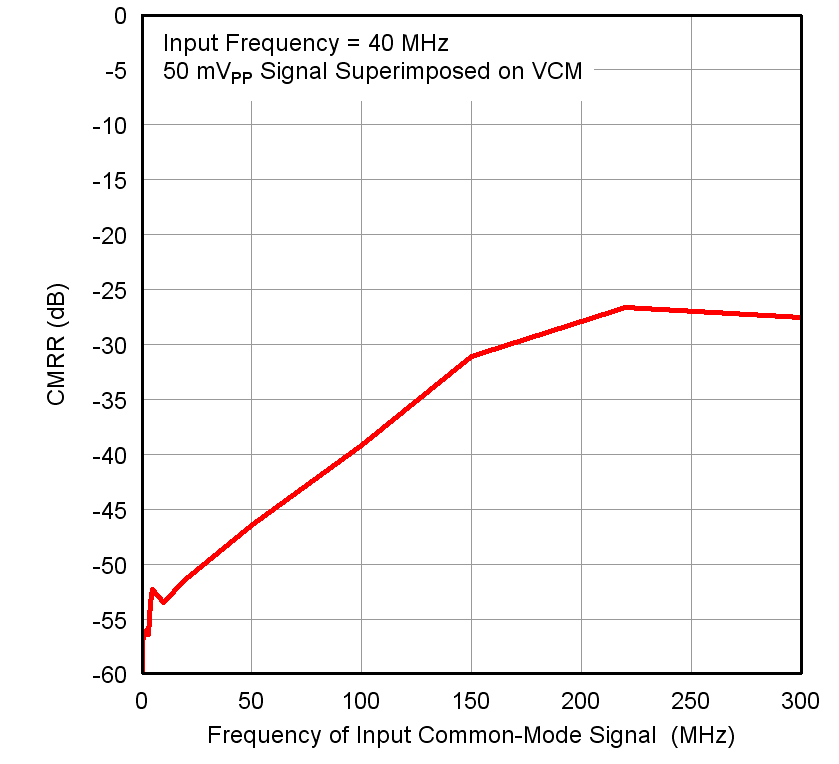 Figure 26. CMRR vs Test Signal Frequency
Figure 26. CMRR vs Test Signal Frequency
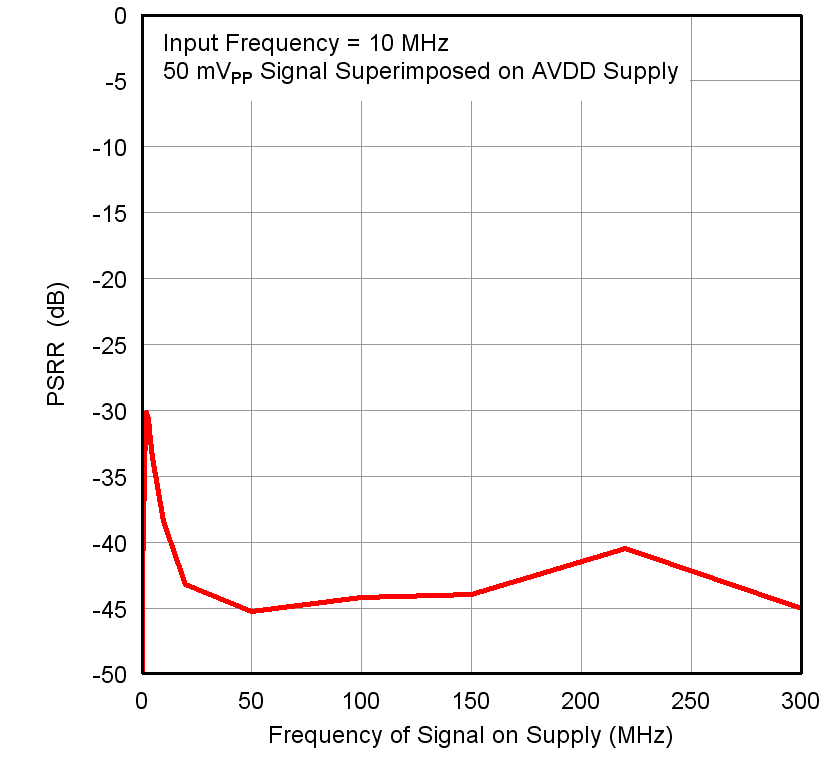 Figure 28. PSRR vs Test Signal Frequency
Figure 28. PSRR vs Test Signal Frequency
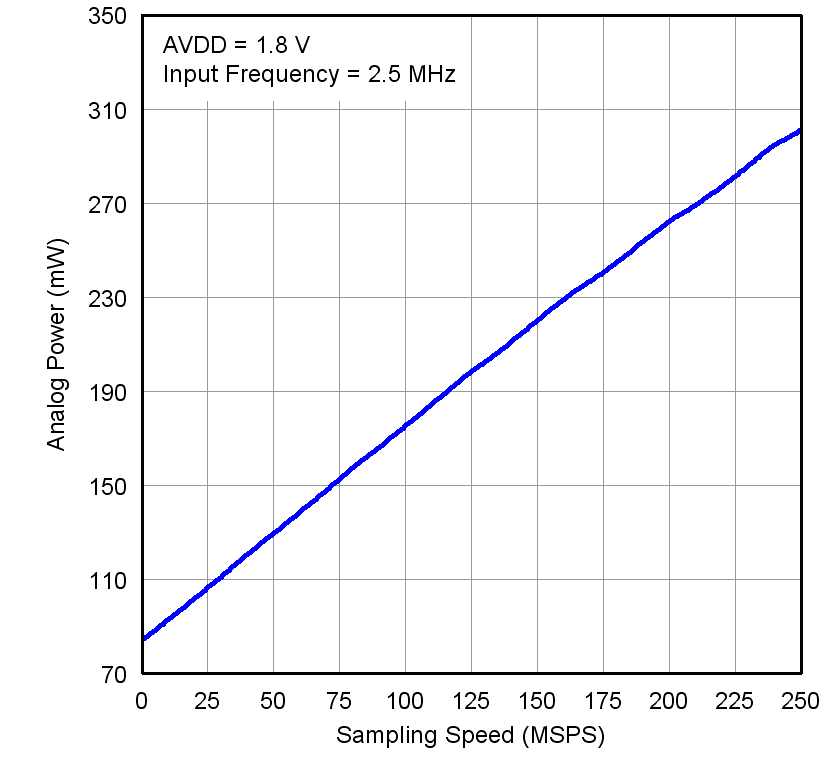 Figure 30. Analog Power vs Sampling Frequency
Figure 30. Analog Power vs Sampling Frequency
7.13.2 Typical Characteristics: Contour
All graphs are at +25°C, AVDD = 1.8 V, DRVDD = 1.8 V, maximum rated sampling frequency, sine wave input clock. 1.5 VPP differential clock amplitude, 50% clock duty cycle, –1-dBFS differential analog input, High-Performance Mode enabled, 0-dB gain, DDR LVDS output interface, and 32k point FFT, unless otherwise noted.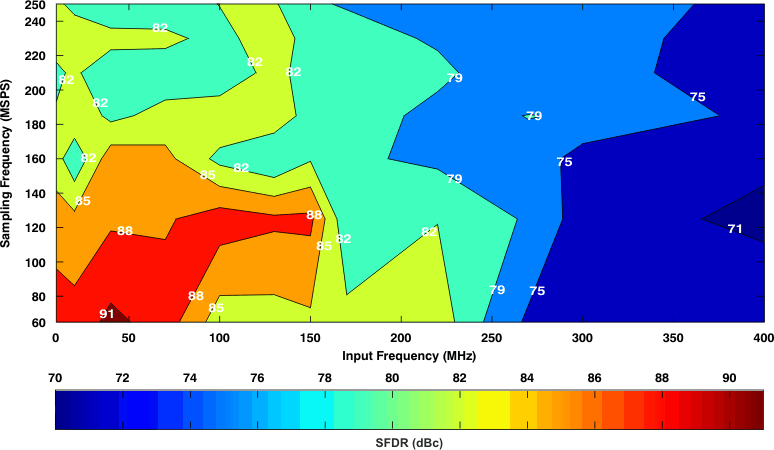 Figure 33. Spurious-Free Dynamic Range (0-dB Gain)
Figure 33. Spurious-Free Dynamic Range (0-dB Gain)
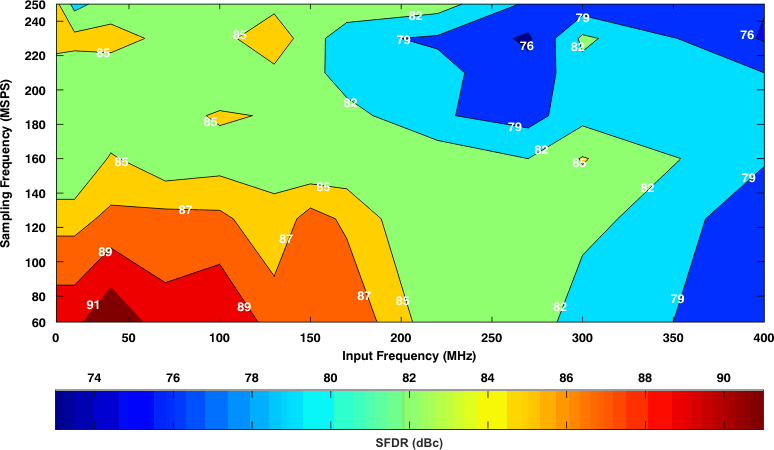 Figure 34. Spurious-Free Dynamic Range (6-dB Gain)
Figure 34. Spurious-Free Dynamic Range (6-dB Gain)
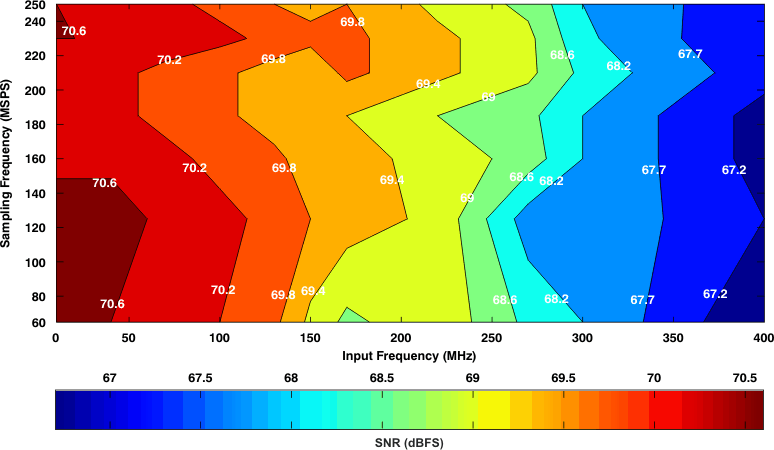 Figure 35. Signal-to-Noise Ratio (0-dB Gain)
Figure 35. Signal-to-Noise Ratio (0-dB Gain)
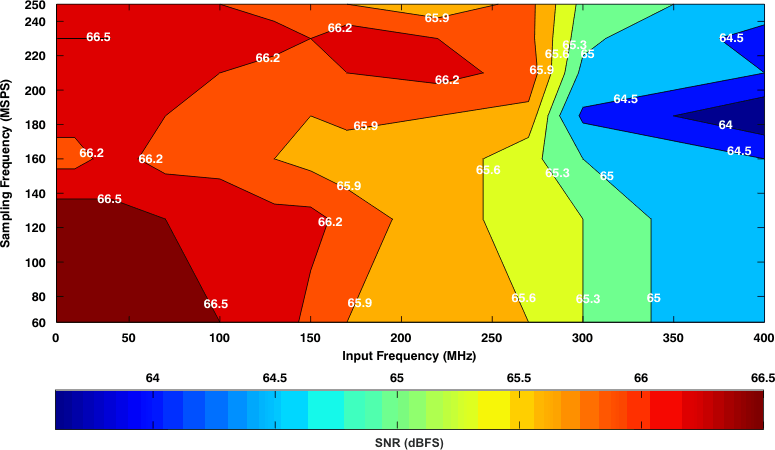 Figure 36. Signal-to-Noise Ratio (6-dB Gain)
Figure 36. Signal-to-Noise Ratio (6-dB Gain)
8 Detailed Description
8.1 Overview
The ADS4229 belongs to TI's ultra low-power family of dual-channel, 12-bit analog-to-digital converters (ADCs). High performance is maintained while reducing power for power sensitive applications. In addition to its low power and high performance, the ADS4229 has a number of digital features and operating modes to enable design flexibility.
8.2 Functional Block Diagram
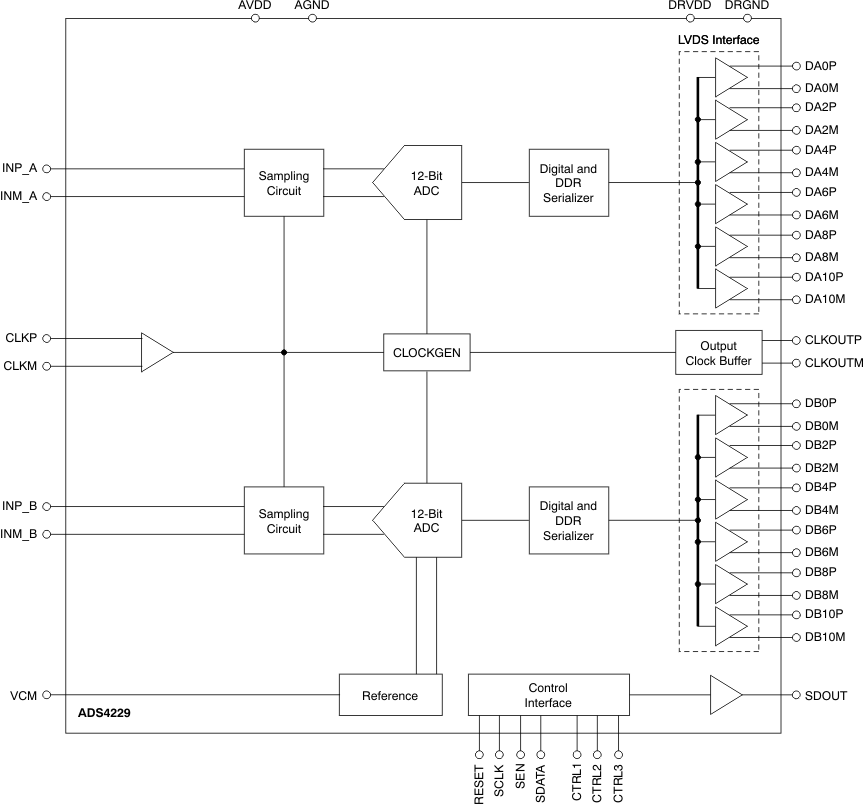
8.3 Feature Description
8.3.1 Digital Functions
The device has several useful digital functions (such as test patterns, gain, and offset correction). These functions require extra clock cycles for operation and increase the overall latency and power of the device. These digital functions are disabled by default after reset and the raw ADC output is routed to the output data pins with a latency of 16 clock cycles. Figure 37 shows more details of the processing after the ADC. In order to use any of the digital functions, the EN DIGITAL bit must be set to '1'. After this, the respective register bits must be programmed as described in the following sections and in the Serial Register Map section.
 Figure 37. Digital Processing Block
Figure 37. Digital Processing Block
8.3.2 Gain for SFDR/SNR Trade-off
The ADS4229 includes gain settings that can be used to get improved SFDR performance (compared to no gain). The gain is programmable from 0 dB to 6 dB (in 0.5-dB steps). For each gain setting, the analog input full-scale range scales proportionally, as shown in Table 2.
The SFDR improvement is achieved at the expense of SNR; for each gain setting, the SNR degrades approximately between 0.5 dB and 1 dB. The SNR degradation is reduced at high input frequencies. As a result, the gain is very useful at high input frequencies because the SFDR improvement is significant with marginal degradation in SNR. Therefore, the gain can be used as a trade-off between SFDR and SNR. Note that the default gain after reset is 0 dB.
Table 2. Full-Scale Range Across Gains
| GAIN (dB) | TYPE | FULL-SCALE (VPP) |
|---|---|---|
| 0 | Default after reset | 2 |
| 1 | Fine, programmable | 1.78 |
| 2 | Fine, programmable | 1.59 |
| 3 | Fine, programmable | 1.42 |
| 4 | Fine, programmable | 1.26 |
| 5 | Fine, programmable | 1.12 |
| 6 | Fine, programmable | 1 |
8.3.3 Offset Correction
The ADS4229 has an internal offset corretion algorithm that estimates and corrects dc offset up to ±10 mV. The correction can be enabled using the ENABLE OFFSET CORR serial register bit. Once enabled, the algorithm estimates the channel offset and applies the correction every clock cycle. The time constant of the correction loop is a function of the sampling clock frequency. The time constant can be controlled using the OFFSET CORR TIME CONSTANT register bits, as described in Table 3.
After the offset is estimated, the correction can be frozen by setting FREEZE OFFSET CORR = 0. Once frozen, the last estimated value is used for the offset correction of every clock cycle. Note that offset correction is disabled by default after reset.
Table 3. Time Constant of Offset Correction Algorithm
| OFFSET CORR TIME CONSTANT | TIME CONSTANT, TCCLK
(Number of Clock Cycles) |
TIME CONSTANT, TCCLK × 1/fS (ms)(1) |
|---|---|---|
| 0000 | 1 M | 4 |
| 0001 | 2 M | 8 |
| 0010 | 4 M | 16 |
| 0011 | 8 M | 32 |
| 0100 | 16 M | 64 |
| 0101 | 32 M | 128 |
| 0110 | 64 M | 256 |
| 0111 | 128 M | 512 |
| 1000 | 256 M | 1024 |
| 1001 | 512 M | 2048 |
| 1010 | 1 G | 4096 |
| 1011 | 2 G | 8192 |
| 1100 | Reserved | — |
| 1101 | Reserved | — |
| 1110 | Reserved | — |
| 1111 | Reserved | — |
8.3.4 Power-Down
The ADS4229 has two power-down modes: global power-down and channel standby. These modes can be set using either the serial register bits or using the control pins CTRL1 to CTRL3 (as shown in Table 4).
Table 4. Power-Down Settings
| CTRL1 | CTRL2 | CTRL3 | DESCRIPTION |
|---|---|---|---|
| Low | Low | Low | Default |
| Low | Low | High | Not available |
| Low | High | Low | Not available |
| Low | High | High | Not available |
| High | Low | Low | Global power-down |
| High | Low | High | Channel A powered down, channel B is active |
| High | High | Low | Not available |
| High | High | High | MUX mode of operation, channel A and B data is multiplexed and output on DB[10:0] pins |
8.3.4.1 Global Power-Down
In this mode, the entire chip (including ADCs, internal reference, and output buffers) are powered down, resulting in reduced total power dissipation of approximately 20 mW when the CTRL pins are used and 3mW when the PDN GLOBAL serial register bit is used. The output buffers are in high-impedance state. The wake-up time from global power-down to data becoming valid in normal mode is typically 100 µs.
8.3.4.2 Channel Standby
In this mode, each ADC channel can be powered down. The internal references are active, resulting in a quick wake-up time of 50 µs. The total power dissipation in standby is approximately 250 mW at 250 MSPS.
8.3.4.3 Input Clock Stop
In addition to the previous modes, the converter enters a low-power mode when the input clock frequency falls below 1 MSPS. The power dissipation is approximately 160 mW.
8.3.5 Output Data Format
Two output data formats are supported: twos complement and offset binary. The format can be selected using the DATA FORMAT serial interface register bit or by controlling the DFS pin in parallel configuration mode.
In the event of an input voltage overdrive, the digital outputs go to the appropriate full-scale level. For a positive overdrive, the output code is FFFh for the ADS4229 in offset binary output format; the output code is 7FFh for the ADS4229 in twos complement output format. For a negative input overdrive, the output code is 0000h in offset binary output format and 800h for the ADS4229 in twos complement output format.
8.4 Device Functional Modes
8.4.1 Output Interface Modes
The ADS4229 provides 12-bit digital data for each channel and an output clock synchronized with the data.
8.4.1.1 Output Interface
Two output interface options are available: double data rate (DDR) LVDS and parallel CMOS. They can be selected using the serial interface register bit or by setting the proper voltage on the SEN pin in parallel configuration mode.
8.4.1.2 DDR LVDS Outputs
In this mode, the data bits and clock are output using low-voltage differential signal (LVDS) levels. Two data bits are multiplexed and output on each LVDS differential pair, as shown in Figure 38.
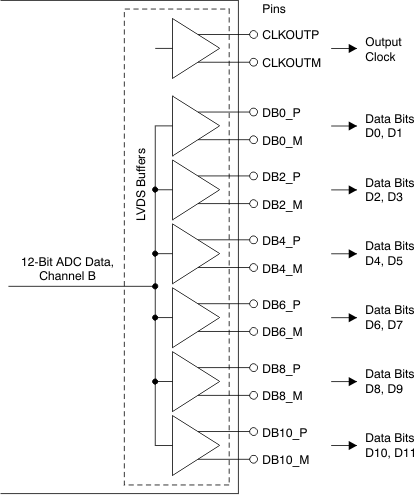 Figure 38. LVDS Interface
Figure 38. LVDS Interface
Even data bits (D0, D2, D4, and so forth) are output at the CLKOUTP rising edge and the odd data bits (D1, D3, D5, and so forth) are output at the CLKOUTP falling edge. Both the CLKOUTP rising and falling edges must be used to capture all the data bits, as shown in Figure 39.
 Figure 39. DDR LVDS Interface Timing
Figure 39. DDR LVDS Interface Timing
8.4.1.3 LVDS Buffer
The equivalent circuit of each LVDS output buffer is shown in Figure 40. After reset, the buffer presents an output impedance of 100Ω to match with the external 100-Ω termination.
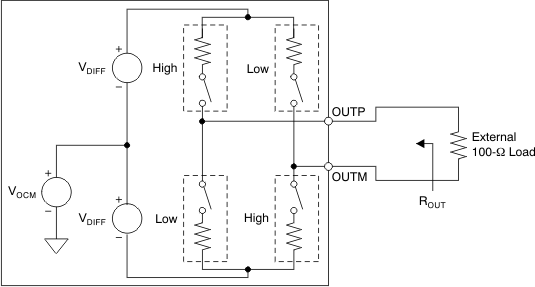
The VDIFF voltage is nominally 350 mV, resulting in an output swing of ±350 mV with 100-Ω external termination. The VDIFF voltage is programmable using the LVDS SWING register bits from ±125 mV to ±570 mV.
Additionally, a mode exists to double the strength of the LVDS buffer to support 50-Ω differential termination, as shown in Figure 41. This mode can be used when the output LVDS signal is routed to two separate receiver chips, each using a 100-Ω termination. The mode can be enabled using the LVDS DATA STRENGTH and LVDS CLKOUT STRENGTH register bits for data and output clock buffers, respectively.
The buffer output impedance behaves in the same way as a source-side series termination. By absorbing reflections from the receiver end, it helps to improve signal integrity.
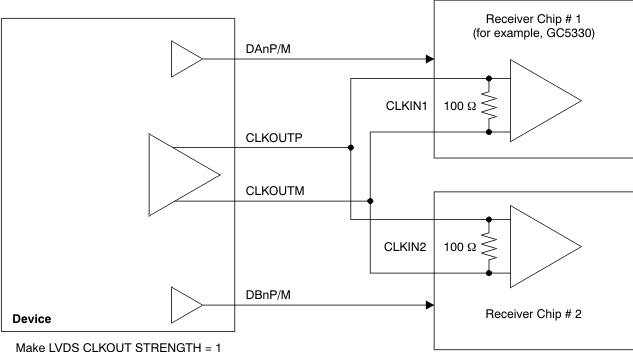 Figure 41. LVDS Buffer Differential Termination
Figure 41. LVDS Buffer Differential Termination
8.4.1.4 Parallel CMOS Interface
In the CMOS mode, each data bit is output on separate pins as CMOS voltage level, every clock cycle, as Figure 42 shows. The rising edge of the output clock CLKOUT can be used to latch data in the receiver. It is recommended to minimize the load capacitance of the data and clock output pins by using short traces to the receiver. Furthermore, match the output data and clock traces to minimize the skew between them.
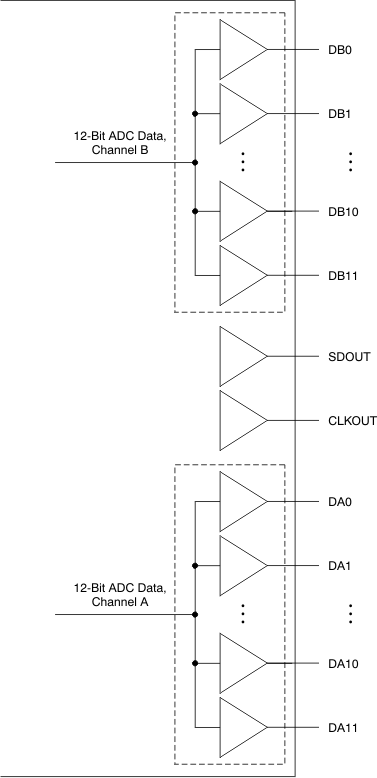 Figure 42. CMOS Outputs
Figure 42. CMOS Outputs
8.4.1.5 CMOS Interface Power Dissipation
With CMOS outputs, the DRVDD current scales with the sampling frequency and the load capacitance on every output pin. The maximum DRVDD current occurs when each output bit toggles between 0 and 1 every clock cycle. In actual applications, this condition is unlikely to occur. The actual DRVDD current would be determined by the average number of output bits switching, which is a function of the sampling frequency and the nature of the analog input signal. This relationship is shown by the formula:
where
- CL = load capacitance,
- N × FAVG = average number of output bits switching.
8.4.1.6 Multiplexed Mode of Operation
In this mode, the digital outputs of both channels are multiplexed and output on a single bus (DB[11:0] pins), as shown in Figure 43. The channel A output pins (DA[11:0]) are in 3-state. Because the output data rate on the DB bus is effectively doubled, this mode is recommended only for low sampling frequencies (less than 80 MSPS). This mode can be enabled using the POWER-DOWN MODE register bits or using the CTRL[3:1] parallel pins.
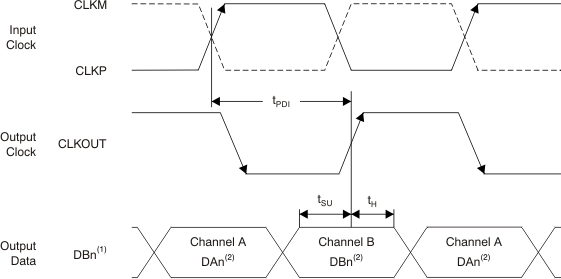
8.5 Programming
Table 5 shows all the high-performance modes for the ADS4229 device.
Table 5. High-Performance Modes(1)(2)
8.5.1 Device Configuration
The ADS4229 can be configured independently using either parallel interface control or serial interface programming.
8.5.2 Parallel Configuration Only
To put the device into parallel configuration mode, keep RESET tied high (AVDD). Then, use the SEN, SCLK, CTRL1, CTRL2, and CTRL3 pins to directly control certain modes of the ADC. The device can be easily configured by connecting the parallel pins to the correct voltage levels (as described in Table 6 to Table 9). There is no need to apply a reset and SDATA can be connected to ground.
In this mode, SEN and SCLK function as parallel interface control pins. Some frequently-used functions can be controlled using these pins. Table 6 describes the modes controlled by the parallel pins.
Table 6. Parallel Pin Definition
| PIN | CONTROL MODE |
|---|---|
| SCLK | Low-speed mode selection |
| SEN | Output data format and output interface selection |
| CTRL1 | Together, these pins control the power-down modes |
| CTRL2 | |
| CTRL3 |
8.5.3 Serial Interface Configuration Only
To enable this mode, the serial registers must first be reset to the default values and the RESET pin must be kept low. SEN, SDATA, and SCLK function as serial interface pins in this mode and can be used to access the internal registers of the ADC. The registers can be reset either by applying a pulse on the RESET pin or by setting the RESET bit high. The Serial Register Map section describes the register programming and the register reset process in more detail.
8.5.4 Using Both Serial Interface and Parallel Controls
For increased flexibility, a combination of serial interface registers and parallel pin controls (CTRL1 to CTRL3) can also be used to configure the device. To enable this option, keep RESET low. The parallel interface control pins CTRL1 to CTRL3 are available. After power-up, the device is automatically configured according to the voltage settings on these pins (see Table 9). SEN, SDATA, and SCLK function as serial interface digital pins and are used to access the internal registers of the ADC. The registers must first be reset to the default values either by applying a pulse on the RESET pin or by setting the RESET bit to '1'. After reset, the RESET pin must be kept low. The Serial Register Map section describes register programming and the register reset process in more detail.
8.5.5 Parallel Configuration Details
The functions controlled by each parallel pin are described in Table 7, Table 8, and Table 9. A simple way of configuring the parallel pins is shown in Figure 44.
Table 7. SCLK Control Pin
| VOLTAGE APPLIED ON SCLK | DESCRIPTION |
|---|---|
| Low | Low-speed mode is disabled |
| High | Low-speed mode is enabled |
Table 8. SEN Control Pin
| VOLTAGE APPLIED ON SEN | DESCRIPTION |
|---|---|
| 0 (+50mV/0mV) |
Twos complement and parallel CMOS output |
| (3/8) AVDD (±50mV) |
Offset binary and parallel CMOS output |
| (5/8) 2AVDD (±50mV) |
Offset binary and DDR LVDS output |
| AVDD (0mV/–50mV) |
Twos complement and DDR LVDS output |
Table 9. CTRL1, CTRL2, and CTRL3 Pins
| CTRL1 | CTRL2 | CTRL3 | DESCRIPTION |
|---|---|---|---|
| Low | Low | Low | Normal operation |
| Low | Low | High | Not available |
| Low | High | Low | Not available |
| Low | High | High | Not available |
| High | Low | Low | Global power-down |
| High | Low | High | Channel A standby, channel B is active |
| High | High | Low | Not available |
| High | High | High | MUX mode of operation, channel A and B data are multiplexed and output on the DB[11:0] pins. |
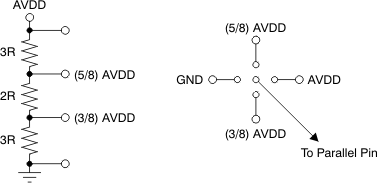 Figure 44. Simple Scheme to Configure the Parallel Pins
Figure 44. Simple Scheme to Configure the Parallel Pins
8.5.6 Serial Interface Details
The ADC has a set of internal registers that can be accessed by the serial interface formed by the SEN (serial interface enable), SCLK (serial interface clock), and SDATA (serial interface data) pins. Serial shift of bits into the device is enabled when SEN is low. Serial data SDATA are latched at every SCLK falling edge when SEN is active (low). The serial data are loaded into the register at every 16th SCLK falling edge when SEN is low. When the word length exceeds a multiple of 16 bits, the excess bits are ignored. Data can be loaded in multiples of 16-bit words within a single active SEN pulse. The first eight bits form the register address and the remaining eight bits are the register data. The interface can work with SCLK frequencies from 20 MHz down to very low speeds (of a few hertz) and also with non-50% SCLK duty cycle.
8.5.6.1 Register Initialization
After power-up, the internal registers must be initialized to the default values. Initialization can be accomplished in one of two ways:
- Through a hardware reset by applying a high pulse on the RESET pin (of width greater than 10 ns), as shown in Figure 5 and Serial Interface Timing Characteristics; or
- By applying a software reset. When using the serial interface, set the RESET bit high. This setting initializes the internal registers to the default values and then self-resets the RESET bit low. In this case, the RESET pin is kept low. See Reset Timing (Only when Serial Interface is Used) and Figure 6 for reset timing.
8.5.6.2 Serial Register Readout
The device includes a mode where the contents of the internal registers can be read back. This readback mode may be useful as a diagnostic check to verify the serial interface communication between the external controller and the ADC. To use readback mode, follow this procedure:
- Set the READOUT register bit to '1'. This setting disables any further writes to the registers.
- Initiate a serial interface cycle specifying the address of the register (A7 to A0) whose content has to be read.
- The device outputs the contents (D7 to D0) of the selected register on the SDOUT pin (pin 64).
- The external controller can latch the contents at the SCLK falling edge.
- To enable register writes, reset the READOUT register bit to '0'.
The serial register readout works with both CMOS and LVDS interfaces on pin 64. See Figure 45 for serial readout timing diagram.
When READOUT is disabled, the SDOUT pin is in high-impedance state.
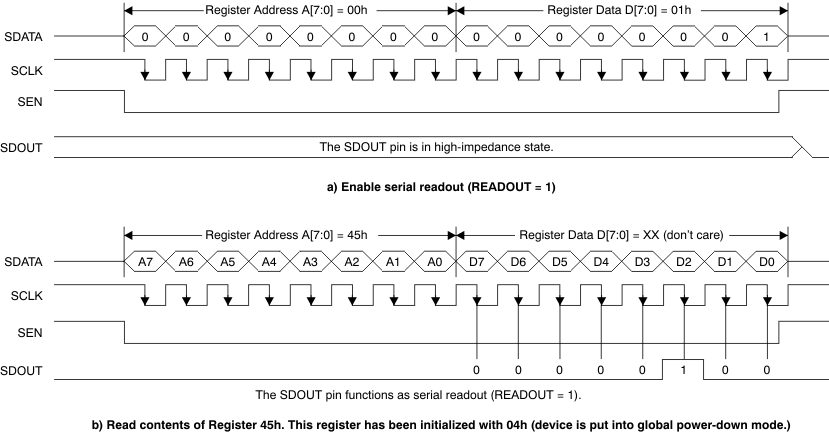 Figure 45. Serial Readout Timing Diagram
Figure 45. Serial Readout Timing Diagram
8.6 Register Maps
8.6.1 Serial Register Map
Table 10 summarizes the functions supported by the serial interface.
Table 10. Serial Interface Register Map(1)
| REGISTER ADDRESS | REGISTER DATA | |||||||
|---|---|---|---|---|---|---|---|---|
| A[7:0] (Hex) | D7 | D6 | D5 | D4 | D3 | D2 | D1 | D0 |
| 00 | 0 | 0 | 0 | 0 | 0 | 0 | RESET | READOUT |
| 01 | LVDS SWING | 0 | 0 | |||||
| 03 | 0 | 0 | 0 | 0 | 0 | 0 | HIGH PERF MODE 2 | HIGH PERF MODE 1 |
| 25 | CH A GAIN | 0 | CH A TEST PATTERNS | |||||
| 29 | 0 | 0 | 0 | DATA FORMAT | 0 | 0 | 0 | |
| 2B | CH B GAIN | 0 | CH B TEST PATTERNS | |||||
| 3D | 0 | 0 | ENABLE OFFSET CORR | 0 | 0 | 0 | 0 | 0 |
| 3F | 0 | 0 | CUSTOM PATTERN D[11:6] | |||||
| 40 | CUSTOM PATTERN D[5:0] | 0 | 0 | |||||
| 41 | LVDS CMOS | CMOS CLKOUT STRENGTH | 0 | 0 | DIS OBUF | |||
| 42 | CLKOUT FALL POSN | CLKOUT RISE POSN | EN DIGITAL | 0 | 0 | 0 | ||
| 45 | STBY | LVDS CLKOUT STRENGTH | LVDS DATA STRENGTH | 0 | 0 | PDN GLOBAL | 0 | 0 |
| 4A | 0 | 0 | 0 | 0 | 0 | 0 | 0 | HIGH FREQ MODE CH B |
| 58 | 0 | 0 | 0 | 0 | 0 | 0 | 0 | HIGH FREQ MODE CH A |
| BF | CH A OFFSET PEDESTAL | 0 | 0 | 0 | 0 | |||
| C1 | CH B OFFSET PEDESTAL | 0 | 0 | 0 | 0 | |||
| CF | FREEZE OFFSET CORR | 0 | OFFSET CORR TIME CONSTANT | 0 | 0 | |||
| EF | 0 | 0 | 0 | EN LOW SPEED MODE | 0 | 0 | 0 | 0 |
| F1 | 0 | 0 | 0 | 0 | 0 | 0 | EN LVDS SWING | |
| F2 | 0 | 0 | 0 | 0 | LOW SPEED MODE CH A | 0 | 0 | 0 |
| 2 | 0 | HIGH PERF MODE3 | 0 | 0 | 0 | 0 | 0 | 0 |
| D5 | 0 | 0 | 0 | HIGH PERF MODE4 | HIGH PERF MODE5 | 0 | 0 | 0 |
| D7 | 0 | 0 | 0 | 0 | HIGH PERF MODE6 | HIGH PERF MODE7 | 0 | 0 |
| DB | 0 | 0 | HIGH PERF MODE8 | 0 | 0 | 0 | 0 | LOW SPEED MODE CH B |
8.6.2 Description of Serial Registers
8.6.2.1 Register Address 00h (Default = 00h)
| 7 | 6 | 5 | 4 | 3 | 2 | 1 | 0 |
| 0 | 0 | 0 | 0 | 0 | 0 | RESET | READOUT |
| Bits[7:2] | Always write '0' |
| Bit 1 | RESET: Software reset applied |
| This bit resets all internal registers to the default values and self-clears to 0 (default = 1). | |
| Bit 0 | READOUT: Serial readout |
| This bit sets the serial readout of the registers. 0 = Serial readout of registers disabled; the SDOUT pin is placed in a high-impedance state. 1 = Serial readout enabled; the SDOUT pin functions as a serial data readout with CMOS logic levels running from the DRVDD supply. See the Serial Register Readout section. |
8.6.2.2 Register Address 01h (Default = 00h)
| 7 | 6 | 5 | 4 | 3 | 2 | 1 | 0 |
| LVDS SWING | 0 | 0 | |||||
| Bits[7:2] | LVDS SWING: LVDS swing programmability |
| These bits program the LVDS swing. Set the EN LVDS SWING bit to '1' before programming swing. 000000 = Default LVDS swing; ±350 mV with external 100-Ω termination 011011 = LVDS swing increases to ±410 mV 110010 = LVDS swing increases to ±465 mV 010100 = LVDS swing increases to ±570 mV 111110 = LVDS swing increases to ±200 mV 001111 = LVDS swing increases to ±125 mV |
|
| Bits[1:0] | Always write '0' |
8.6.2.3 Register Address 03h (Default = 00h)
| 7 | 6 | 5 | 4 | 3 | 2 | 1 | 0 |
| 0 | 0 | 0 | 0 | 0 | 0 | HIGH PERF MODE 2 | HIGH PERF MODE 1 |
| Bits[7:2] | Always write '0' |
| Bits[1:0] | HIGH PERF MODE[2:1]: High-performance mode |
| 00 = Default performance 01 = Do not use 10 = Do not use 11 = Obtain best performance across sample clock and input signal frequencies |
8.6.2.4 Register Address 25h (Default = 00h)
| 7 | 6 | 5 | 4 | 3 | 2 | 1 | 0 |
| CH A GAIN | 0 | CH A TEST PATTERNS | |||||
| Bits[7:4] | CH A GAIN: Channel A gain programmability | ||
| These bits set the gain programmability in 0.5-dB steps for channel A. | |||
| 0000 = 0-dB gain (default after reset) 0001 = 0.5-dB gain 0010 = 1-dB gain 0011 = 1.5-dB gain 0100 = 2-dB gain 0101 = 2.5-dB gain 0110 = 3-dB gain 0111 = 3.5-dB gain 1000 = 4-dB gain 1001 = 4.5-dB gain 1010 = 5-dB gain 1011 = 5.5-dB gain 1100 = 6-dB gain |
|||
| Bit 3 | Always write '0' | ||
| Bits[2:0] | CH A TEST PATTERNS: Channel A data capture | ||
| These bits verify data capture for channel A. 000 = Normal operation 001 = Outputs all 0s 010 = Outputs all 1s 011 = Outputs toggle pattern. For the ADS4229, the output data D[11:0] are an alternating sequence of 101010101010 and 010101010101. 100 = Outputs digital ramp. 101 = Outputs custom pattern; use registers 3Fh and 40h to set the custom pattern 110 = Unused 111 = Unused |
|||
8.6.2.5 Register Address 29h (Default = 00h)
| 7 | 6 | 5 | 4 | 3 | 2 | 1 | 0 |
| 0 | 0 | 0 | DATA FORMAT | 0 | 0 | 0 | |
| Bits[7:5] | Always write '0' | ||
| Bits[4:3] | DATA FORMAT: Data format selection | ||
| 00 = Twos complement 01 = Twos complement 10 = Twos complement 11 = Offset binary |
|||
| Bits[2:0] | Always write '0' | ||
8.6.2.6 Register Address 2Bh (Default = 00h)
| 7 | 6 | 5 | 4 | 3 | 2 | 1 | 0 |
| CH B GAIN | 0 | CH B TEST PATTERNS | |||||
| Bits[7:4] | CH B GAIN: Channel B gain programmability | ||
| These bits set the gain programmability in 0.5-dB steps for channel B. | |||
| 0000 = 0-dB gain (default after reset) 0001 = 0.5-dB gain 0010 = 1-dB gain 0011 = 1.5-dB gain 0100 = 2-dB gain 0101 = 2.5-dB gain 0110 = 3-dB gain 0111 = 3.5-dB gain 1000 = 4-dB gain 1001 = 4.5-dB gain 1010 = 5-dB gain 1011 = 5.5-dB gain 1100 = 6-dB gain |
|||
| Bit 3 | Always write '0' | ||
| Bits[2:0] | CH B TEST PATTERNS: Channel B data capture | ||
| These bits verify data capture for channel B. 000 = Normal operation 001 = Outputs all 0s 010 = Outputs all 1s 011 = Outputs toggle pattern. For the ADS4229, the output data D[11:0] are an alternating sequence of 101010101010 and 010101010101. 100 = Outputs digital ramp. 101 = Outputs custom pattern; use registers 3Fh and 40h to set the custom pattern 110 = Unused 111 = Unused |
|||
8.6.2.7 Register Address 3Dh (Default = 00h)
| 7 | 6 | 5 | 4 | 3 | 2 | 1 | 0 |
| 0 | 0 | ENABLE OFFSET CORR | 0 | 0 | 0 | 0 | 0 |
| Bits[7:6] | Always write '0' |
| Bit 5 | ENABLE OFFSET CORR: Offset correction setting |
| This bit enables the offset correction. 0 = Offset correction disabled 1 = Offset correction enabled |
|
| Bits[4:0] | Always write '0' |
8.6.2.8 Register Address 3Fh (Default = 00h)
| 7 | 6 | 5 | 4 | 3 | 2 | 1 | 0 |
| 0 | 0 | CUSTOM PATTERN D11 | CUSTOM PATTERN D10 | CUSTOM PATTERN D9 | CUSTOM PATTERN D8 | CUSTOM PATTERN D7 | CUSTOM PATTERN D6 |
| Bits[7:6] | Always write '0' |
| Bits[5:0] | CUSTOM PATTERN D[11:6] |
| These are the six upper bits of the custom pattern available at the output instead of ADC data. The ADS4229 custom pattern is 12-bit. |
8.6.2.9 Register Address 40h (Default = 00h)
| 7 | 6 | 5 | 4 | 3 | 2 | 1 | 0 |
| CUSTOM PATTERN D5 | CUSTOM PATTERN D4 | CUSTOM PATTERN D3 | CUSTOM PATTERN D2 | CUSTOM PATTERN D1 | CUSTOM PATTERN D0 | 0 | 0 |
8.6.2.10 Register Address 41h (Default = 00h)
| 7 | 6 | 5 | 4 | 3 | 2 | 1 | 0 |
| LVDS CMOS | CMOS CLKOUT STRENGTH | 0 | 0 | DIS OBUF | |||
| Bits[7:6] | LVDS CMOS: Interface selection |
| These bits select the interface. 00 = DDR LVDS interface 01 = DDR LVDS interface 10 = DDR LVDS interface 11 = Parallel CMOS interface |
|
| Bits[5:4] | CMOS CLKOUT STRENGTH |
| These bits control the strength of the CMOS output clock. 00 = Maximum strength (recommended) 01 = Medium strength 10 = Low strength 11 = Very low strength |
|
| Bits[3:2] | Always write '0' |
| Bits[1:0] | DIS OBUF |
| These bits power down data and clock output buffers for both the CMOS and LVDS output interface. When powered down, the output buffers are in 3-state. 00 = Default 01 = Power-down data output buffers for channel B 10 = Power-down data output buffers for channel A 11 = Power-down data output buffers for both channels as well as the clock output buffer |
8.6.2.11 Register Address 42h (Default = 00h)
| 7 | 6 | 5 | 4 | 3 | 2 | 1 | 0 |
| CLKOUT FALL POSN | CLKOUT RISE POSN | EN DIGITAL | 0 | 0 | 0 | ||
| Bits[7:6] | CLKOUT FALL POSN |
| In LVDS mode: 00 = Default 01 = The falling edge of the output clock advances by 450 ps 10 = The falling edge of the output clock advances by 150 ps 11 = The falling edge of the output clock is delayed by 550 ps In CMOS mode: 00 = Default 01 = The falling edge of the output clock is delayed by 150 ps 10 = Do not use 11 = The falling edge of the output clock advances by 100 ps |
|
| Bits[5:6] | CLKOUT RISE POSN |
| In LVDS mode: 00 = Default 01 = The rising edge of the output clock advances by 450 ps 10 = The rising edge of the output clock advances by 150 ps 11 = The rising edge of the output clock is delayed by 250 ps In CMOS mode: 00 = Default 01 = The rising edge of the output clock is delayed by 150 ps 10 = Do not use 11 = The rising edge of the output clock advances by 100 ps |
|
| Bit 3 | EN DIGITAL: Digital function enable |
| 0 = All digital functions disabled 1 = All digital functions (such as test patterns, gain, and offset correction) enabled |
|
| Bits[2:0] | Always write '0' |
8.6.2.12 Register Address 45h (Default = 00h)
| 7 | 6 | 5 | 4 | 3 | 2 | 1 | 0 |
| STBY | LVDS CLKOUT STRENGTH | LVDS DATA STRENGTH | 0 | 0 | PDN GLOBAL | 0 | 0 |
| Bit 7 | STBY: Standby setting | ||
| 0 = Normal operation 1 = Both channels are put in standby; wakeup time from this mode is fast (typically 50 µs). |
|||
| Bit 6 | LVDS CLKOUT STRENGTH: LVDS output clock buffer strength setting | ||
| 0 = LVDS output clock buffer at default strength to be used with 100-Ω external termination 1 = LVDS output clock buffer has double strength to be used with 50-Ω external termination |
|||
| Bit 5 | LVDS DATA STRENGTH | ||
| 0 = All LVDS data buffers at default strength to be used with 100-Ω external termination 1 = All LVDS data buffers have double strength to be used with 50-Ω external termination |
|||
| Bits[4:3] | Always write '0' | ||
| Bit 2 | PDN GLOBAL | ||
| 0 = Normal operation 1 = Total power down; all ADC channels, internal references, and output buffers are powered down. Wakeup time from this mode is slow (typically 100 µs). |
|||
| Bits[1:0] | Always write '0' | ||
8.6.2.13 Register Address 4Ah (Default = 00h)
| 7 | 6 | 5 | 4 | 3 | 2 | 1 | 0 |
| 0 | 0 | 0 | 0 | 0 | 0 | 0 | HIGH FREQ MODE CH B |
| Bits[7:1] | Always write '0' | ||
| Bit 0 | HIGH FREQ MODE CH B: High-frequency mode for channel B | ||
| 0 = Default 1 = Use this mode for high input frequencies greater than 200 MHz |
|||
8.6.2.14 Register Address 58h (Default = 00h)
| 7 | 6 | 5 | 4 | 3 | 2 | 1 | 0 |
| 0 | 0 | 0 | 0 | 0 | 0 | 0 | HIGH FREQ MODE CH A |
| Bits[7:1] | Always write '0' | ||
| Bit 0 | HIGH FREQ MODE CH A: High-frequency mode for channel A | ||
| 0 = Default 1 = Use this mode for high input frequencies greater than 200 MHz |
|||
8.6.2.15 Register Address BFh (Default = 00h)
| 7 | 6 | 5 | 4 | 3 | 2 | 1 | 0 |
| CH A OFFSET PEDESTAL | 0 | 0 | 0 | 0 | |||
| Bits[7:4] | CH A OFFSET PEDESTAL: Channel A offset pedestal selection | ||
| When the offset correction is enabled, the final converged value after the offset is corrected is the ADC midcode value. A pedestal can be added to the final converged value by programming these bits. See the Offset Correction section. Channels can be independently programmed for different offset pedestals by choosing the relevant register address. For the ADS4229, the pedestal ranges from –8 to +7, so the output code can vary from midcode-8 to midcode+7 by adding pedestal D7-D4. |
|||
| Program bits D[7:4] | |||
| 0111 = Midcode+7 0110 = Midcode+6 0101 = Midcode+5 … 0000 = Midcode 1111 = Midcode-1 1110 = Midcode-2 1101 = Midcode-3 … 1000 = Midcode-8 |
|||
| Bits[3:0] | Always write '0' | ||
8.6.2.16 Register Address C1h (Default = 00h)
| 7 | 6 | 5 | 4 | 3 | 2 | 1 | 0 |
| CH B OFFSET PEDESTAL | 0 | 0 | 0 | 0 | |||
| Bits[7:4] | CH B OFFSET PEDESTAL: Channel B offset pedestal selection | |
| When offset correction is enabled, the final converged value after the offset is corrected is the ADC midcode value. A pedestal can be added to the final converged value by programming these bits; see the Offset Correction section. Channels can be independently programmed for different offset pedestals by choosing the relevant register address. For the ADS4229, the pedestal ranges from –8 to +7, so the output code can vary from midcode-8 to midcode+7 by adding pedestal D[7:4]. |
||
| Program Bits D[7:4] | ||
| 0111 = Midcode+7 0110 = Midcode+6 0101 = Midcode+5 … 0000 = Midcode 1111 = Midcode-1 1110 = Midcode-2 1101 = Midcode-3 … 1000 = Midcode-8 |
||
| Bits[3:0] | Always write '0' | |
8.6.2.17 Register Address CFh (Default = 00h)
| 7 | 6 | 5 | 4 | 3 | 2 | 1 | 0 |
| FREEZE OFFSET CORR | 0 | OFFSET CORR TIME CONSTANT | 0 | 0 | |||
| Bit 7 | FREEZE OFFSET CORR: Freeze offset correction setting | |
| This bit sets the freeze offset correction estimation. 0 = Estimation of offset correction is not frozen (the EN OFFSET CORR bit must be set) 1 = Estimation of offset correction is frozen (the EN OFFSET CORR bit must be set); when frozen, the last estimated value is used for offset correction of every clock cycle. See the Offset Correction section. |
||
| Bit 6 | Always write '0' | |
| Bits[5:2] | OFFSET CORR TIME CONSTANT | |
| The offset correction loop time constant in number of clock cycles. Refer to the Offset Correction section. | ||
| Bits[1:0] | Always write '0' | |
8.6.2.18 Register Address EFh (Default = 00h)
| 7 | 6 | 5 | 4 | 3 | 2 | 1 | 0 |
| 0 | 0 | 0 | EN LOW SPEED MODE | 0 | 0 | 0 | 0 |
| Bits[7:5] | Always write '0' |
| Bit 4 | EN LOW SPEED MODE: Enable control of low-speed mode through serial register bits |
| This bit enables the control of the low-speed mode using the LOW SPEED MODE CH B and LOW SPEED MODE CH A register bits. 0 = Low-speed mode is disabled 1 = Low-speed mode is controlled by serial register bits |
|
| Bits[3:0] | Always write '0' |
8.6.2.19 Register Address F1h (Default = 00h)
| 7 | 6 | 5 | 4 | 3 | 2 | 1 | 0 |
| 0 | 0 | 0 | 0 | 0 | 0 | EN LVDS SWING | |
| Bits[7:2] | Always write '0' |
| Bits[1:0] | EN LVDS SWING: LVDS swing enable |
| These bits enable LVDS swing control using the LVDS SWING register bits. 00 = LVDS swing control using the LVDS SWING register bits is disabled 01 = Do not use 10 = Do not use 11 = LVDS swing control using the LVDS SWING register bits is enabled |
8.6.2.20 Register Address F2h (Default = 00h)
| 7 | 6 | 5 | 4 | 3 | 2 | 1 | 0 |
| 0 | 0 | 0 | 0 | LOW SPEED MODE CH A | 0 | 0 | 0 |
| Bits[7:4] | Always write '0' |
| Bit 3 | LOW SPEED MODE CH A: Channel A low-speed mode enable |
| This bit enables the low-speed mode for channel A. Set the EN LOW SPEED MODE bit to '1' before using this bit. 0 = Low-speed mode is disabled for channel A 1 = Low-speed mode is enabled for channel A |
|
| Bits[2:0] | Always write '0' |
8.6.2.21 Register Address 2h (Default = 00h)
| 7 | 6 | 5 | 4 | 3 | 2 | 1 | 0 |
| 0 | HIGH PERF MODE3 | 0 | 0 | 0 | 0 | 0 | 0 |
| Bit 7 | Always write '0' |
| Bit 6 | HIGH PERF MODE3 |
| HIGH PERF MODE3 to HIGH PERF MODE8 must be set to '1' to ensure best performance at high sampling speed (greater than 160 MSPS) | |
| Bits[5:0] | Always write '0' |
8.6.2.22 Register Address D5h (Default = 00h)
| 7 | 6 | 5 | 4 | 3 | 2 | 1 | 0 |
| 0 | 0 | 0 | HIGH PERF MODE4 | HIGH PERF MODE5 | 0 | 0 | 0 |
| Bits[7:5] | Always write '0' |
| Bit 4 | HIGH PERF MODE4 |
| HIGH PERF MODE3 to HIGH PERF MODE8 must be set to '1' to ensure best performance at high sampling speed (greater than 160 MSPS) | |
| Bit 3 | HIGH PERF MODE5 |
| HIGH PERF MODE3 to HIGH PERF MODE8 must be set to '1' to ensure best performance at high sampling speed (greater than 160 MSPS) | |
| Bits[2:0] | Always write '0' |
8.6.2.23 Register Address D7h (Default = 00h)
| 7 | 6 | 5 | 4 | 3 | 2 | 1 | 0 |
| 0 | 0 | 0 | 0 | HIGH PERF MODE6 | HIGH PERF MODE7 | 0 | 0 |
| Bits[7:4] | Always write '0' |
| Bit 3 | HIGH PERF MODE6 |
| HIGH PERF MODE3 to HIGH PERF MODE8 must be set to '1' to ensure best performance at high sampling speed (greater than 160 MSPS) | |
| Bit 2 | HIGH PERF MODE7 |
| HIGH PERF MODE3 to HIGH PERF MODE8 must be set to '1' to ensure best performance at high sampling speed (greater than 160 MSPS) | |
| Bits[1:0] | Always write '0' |
8.6.2.24 Register Address DBh (Default = 00h)
| 7 | 6 | 5 | 4 | 3 | 2 | 1 | 0 |
| 0 | 0 | HIGH PERF MODE80 | 0 | 0 | 0 | 0 | LOW SPEED MODE CH B |
| Bits[7:6] | Always write '0' |
| Bit 5 | HIGH PERF MODE8 |
| HIGH PERF MODE3 to HIGH PERF MODE8 must be set to '1' to ensure best performance at high sampling speed (greater than 160 MSPS) | |
| Bits[4:1] | Always write '0' |
| Bit 0 | LOW SPEED MODE CH B: Channel B low-speed mode enable |
| This bit enables the low-speed mode for channel B. Set the EN LOW SPEED MODE bit to '1' before using this bit. 0 = Low-speed mode is disabled for channel B 1 = Low-speed mode is enabled for channel B |
9 Application and Implementation
NOTE
Information in the following applications sections is not part of the TI component specification, and TI does not warrant its accuracy or completeness. TI’s customers are responsible for determining suitability of components for their purposes. Customers should validate and test their design implementation to confirm system functionality.
9.1 Application Information
The ADS4229 dual-channel 12-bit ADC is designed for use in communications receivers designed to receive modern communication signals such as LTE, WIMAX, W-CDMA, and high-order QAM signals. A typical diversity receiver example is shown in Figure 70, where the antennas are placed at some distance to optimize performance in the presence of multipath fading. The path includes a low noise amplifier (LNA), RF mixer, and a digital variable gain amplifier (DVGA). Filtering is used throughout the path to remove blocking signals and mixing products and to prevent aliasing during sampling.
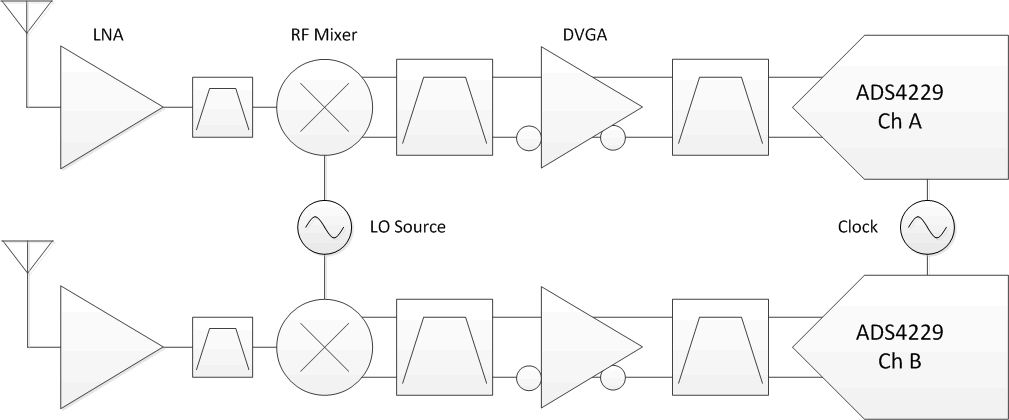 Figure 70. Diversity Communications Receiver
Figure 70. Diversity Communications Receiver
9.1.1 Theory of Operation
At every rising edge of the input clock, the analog input signal of each channel is simultaneously sampled. The sampled signal in each channel is converted by a pipeline of low-resolution stages. In each stage, the sampled/held signal is converted by a high-speed, low-resolution, flash sub-ADC. The difference between the stage input and the quantized equivalent is gained and propagates to the next stage. At every clock, each succeeding stage resolves the sampled input with greater accuracy. The digital outputs from all stages are combined in a digital correction logic block and digitally processed to create the final code after a data latency of 16 clock cycles. The digital output is available as either DDR LVDS or parallel CMOS and coded in either straight offset binary or binary twos complement format. The dynamic offset of the first stage sub-ADC limits the maximum analog input frequency to approximately 400 MHz (with 2-VPP amplitude) or approximately 600 MHz (with 1-VPP amplitude).
9.1.2 Analog Input
The analog input consists of a switched-capacitor-based, differential sample-and-hold (S/H) architecture. This differential topology results in very good ac performance even for high input frequencies at high sampling rates. The INP and INM pins must be externally biased around a common-mode voltage of 0.95 V, available on the VCM pin. For a full-scale differential input, each input pin (INP and INM) must swing symmetrically between
VCM + 0.5 V and VCM – 0.5 V, resulting in a 2-VPP differential input swing. The input sampling circuit has a high 3-dB bandwidth that extends up to 550 MHz (measured from the input pins to the sampled voltage). Figure 71 shows an equivalent circuit for the analog input.
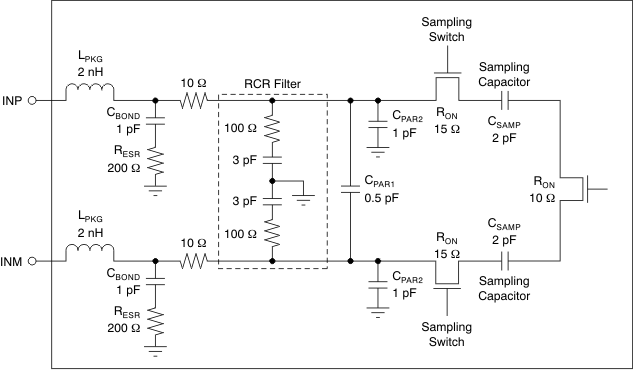 Figure 71. Analog Input Equivalent Circuit
Figure 71. Analog Input Equivalent Circuit
9.1.2.1 Drive Circuit Requirements
For optimum performance, the analog inputs must be driven differentially. This operation improves the common-mode noise immunity and even-order harmonic rejection. A 5-Ω to 15-Ω resistor in series with each input pin is recommended to damp out ringing caused by package parasitics.
SFDR performance can be limited as a result of several reasons, including the effects of sampling glitches; nonlinearity of the sampling circuit; and nonlinearity of the quantizer that follows the sampling circuit. Depending on the input frequency, sample rate, and input amplitude, one of these factors generally plays a dominant part in limiting performance. At very high input frequencies (greater than approximately 300 MHz), SFDR is determined largely by the device sampling circuit nonlinearity. At low input amplitudes, the quantizer nonlinearity usually limits performance.
Glitches are caused by the opening and closing of the sampling switches. The driving circuit should present a low source impedance to absorb these glitches. Otherwise, glitches could limit performance, primarily at low input frequencies (up to approximately 200 MHz). It is also necessary to present low impedance (less than 50 Ω) for the common-mode switching currents. This configuration can be achieved by using two resistors from each input terminated to the common-mode voltage (VCM pin).
The device includes an internal R-C filter from each input to ground. The purpose of this filter is to absorb the sampling glitches inside the device itself. The cutoff frequency of the R-C filter involves a trade-off. A lower cutoff frequency (larger C) absorbs glitches better, but it reduces the input bandwidth. On the other hand, with a higher cutoff frequency (smaller C), bandwidth support is maximized. However, the sampling glitches must then be supplied by the external drive circuit. This tradeoff has limitations as a result of the presence of the package bond-wire inductance.
In the ADS4229, the R-C component values have been optimized while supporting high input bandwidth (up to 550 MHz). However, in applications with input frequencies up to 200 MHz to 300 MHz, the filtering of the glitches can be improved further using an external R-C-R filter; see Figure 74 and Figure 75.
In addition, the drive circuit may have to be designed to provide a low insertion loss over the desired frequency range and matched impedance to the source. Furthermore, the ADC input impedance must be considered. Figure 72 and Figure 73 show the impedance (ZIN = RIN || CIN) looking into the ADC input pins.
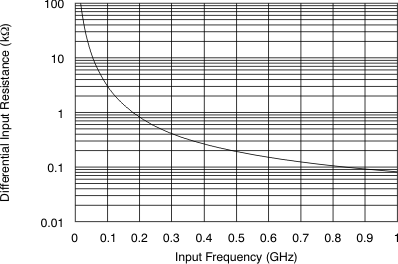 Figure 72. ADC Analog Input Resistance (RIN) Across Frequency
Figure 72. ADC Analog Input Resistance (RIN) Across Frequency
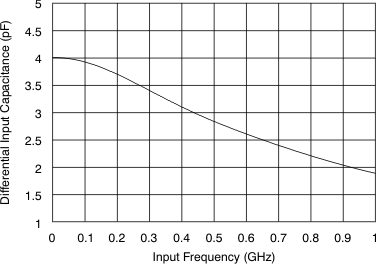 Figure 73. ADC Analog Input Capacitance (CIN) Across Frequency
Figure 73. ADC Analog Input Capacitance (CIN) Across Frequency
9.1.2.2 Driving Circuit
Figure 74, Figure 75, and Figure 76 show examples of driving circuit configurations optimized for low bandwidth (to support low input frequencies), high bandwidth (to support higher input frequencies), and very high bandwidth, respectively. Note that each of the drive circuits has been terminated by 50 Ω near the ADC side. The transformers (such as ADTL1-1WT or WBC1-1) can be used up to 270 MHz IF. For very high IF (> 270 MHz), transformer ADTL2-18 can be used. The termination is accomplished by a 25-Ω resistor from each input to the 0.95-V common-mode (VCM) from the device. This architecture allows the analog inputs to be biased around the required common-mode voltage.
The mismatch in the transformer parasitic capacitance (between the windings) results in degraded even-order harmonic performance. Connecting two identical RF transformers back-to-back helps minimize this mismatch; good performance is obtained for high-frequency input signals. An optional termination resistor pair may be required between the two transformers, as shown in Figure 74, Figure 75, and Figure 76. The center point of this termination is connected to ground to improve the balance between the P and M sides. The values of the terminations between the transformers and on the secondary side must be chosen to obtain an effective 50 Ω (in the case of 50-Ω source impedance).
 Figure 74. Drive Circuit With Low Bandwidth (for Low Input Frequencies Less Than 150 MHz)
Figure 74. Drive Circuit With Low Bandwidth (for Low Input Frequencies Less Than 150 MHz)
 Figure 75. Drive Circuit With High Bandwidth (for High Input Frequencies Greater Than 150 MHz and Less Than 270 MHz)
Figure 75. Drive Circuit With High Bandwidth (for High Input Frequencies Greater Than 150 MHz and Less Than 270 MHz)
 Figure 76. Drive Circuit With Very High Bandwidth (Greater Than 270 MHz)
Figure 76. Drive Circuit With Very High Bandwidth (Greater Than 270 MHz)
All of these examples show 1:1 transformers being used with a 50-Ω source. As explained in the Drive Circuit Requirements section, this configuration helps to present a low source impedance to absorb the sampling glitches. With a 1:4 transformer, the source impedance is 200 Ω. The higher source impedance is unable to absorb the sampling glitches effectively and can lead to degradation in performance (compared to using 1:1 transformers).
In almost all cases, either a band-pass or low-pass filter is required to obtain the desired dynamic performance, as shown in Figure 77. Such filters present low source impedance at the high frequencies corresponding to the sampling glitch and help avoid performance losses associated with the high source impedance.
 Figure 77. Drive Circuit With a 1:4 Transformer
Figure 77. Drive Circuit With a 1:4 Transformer
9.1.3 Clock Input
The ADS4229 clock inputs can be driven differentially (sine, LVPECL, or LVDS) or single-ended (LVCMOS), with little or no difference in performance between them. The common-mode voltage of the clock inputs is set to VCM using internal 5-kΩ resistors. This setting allows the use of transformer-coupled drive circuits for sine-wave clock or ac-coupling for LVPECL and LVDS clock sources are shown in Figure 78, Figure 79, and Figure 80. The internal clock buffer is shown in Figure 81.
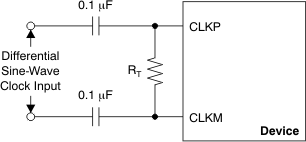
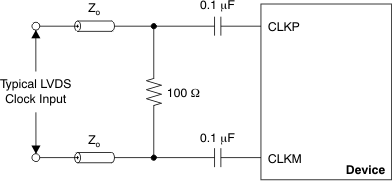 Figure 79. LVDS Clock Driving Circuit
Figure 79. LVDS Clock Driving Circuit
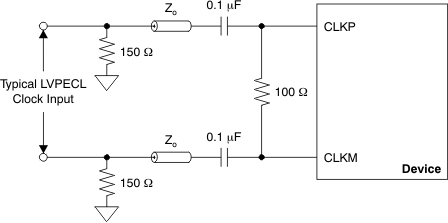 Figure 80. LVPECL Clock Driving Circuit
Figure 80. LVPECL Clock Driving Circuit
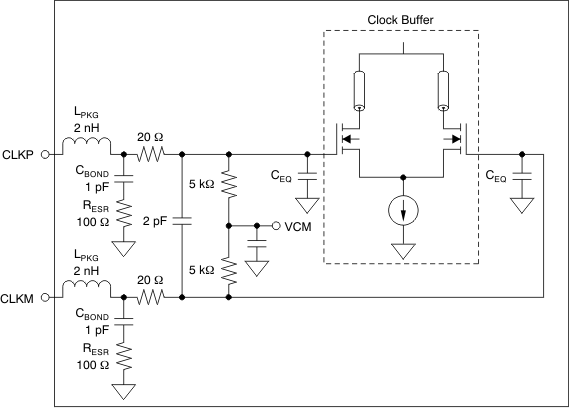
A single-ended CMOS clock can be ac-coupled to the CLKP input, with CLKM connected to ground with a 0.1-μF capacitor, as shown in Figure 82. For best performance, the clock inputs must be driven differentially, thereby reducing susceptibility to common-mode noise. For high input frequency sampling, it is recommended to use a clock source with very low jitter. Band-pass filtering of the clock source can help reduce the effects of jitter. There is no change in performance with a non-50% duty cycle clock input.
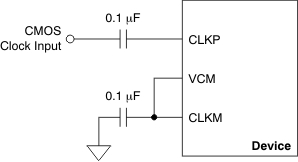 Figure 82. Single-Ended Clock Driving Circuit
Figure 82. Single-Ended Clock Driving Circuit
9.2 Typical Application
An example schematic for a typical application of the ADS4229 is shown in Figure 83.
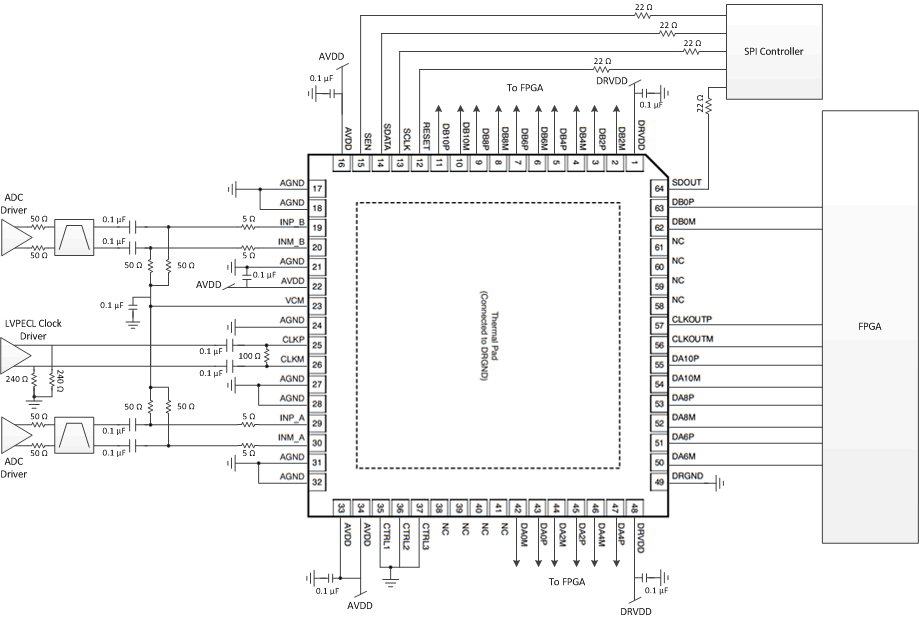 Figure 83. Example Schematic for ADS4229
Figure 83. Example Schematic for ADS4229
9.2.1 Design Requirements
Example design requirements are listed in Table 11 for the ADC portion of the signal chain. These do not necessary reflect the requirements of an actual system, but rather demonstrate why the ADS4229 may be chosen for a system based on a set of requirements.
Table 11. Example Design Requirements for ADS4229
| DESIGN PARAMETER | EXAMPLE DESIGN REQUIREMENT | ADS4229 CAPABILITY |
|---|---|---|
| Sampling rate | ≥ 245.76 Msps to allow 80 MHz of unaliased bandwidth | Max sampling rate: 250 Msps |
| Input frequency | > 250 MHz to accommodate full 2nd nyquist zone operation | Large signal –3 dB bandwidth: 400 MHz |
| SNR | > 65 dBFS at –1 dFBS, 170 MHz | 69.8 dBFS at –1 dBFS, 170 MHz |
| SFDR | > 75 dBc at –1 dFBS, 170 MHz | 80 dBc at –1 dBFS, 170 MHz |
| Input full scale voltage | 2 Vpp | 2 Vpp |
| Channel-to-channel isolation | < 80 dB | 95 dB |
| Overload recovery time | < 3 clock cycles | 1 clock cycle |
| Digital interface | Parallel LVDS | Parallel LVDS |
| Power consumption | < 300 mW per channel | 273 mW per channel |
9.2.2 Detailed Design Procedure
9.2.2.1 Analog Input
The analog inputs of the ADS4229 are typically driven by a fully differential amplifier. The amplifier must have sufficient bandwidth for the frequencies of interest. The noise and distortion performance of the amplifier will affect the combined performance of the ADC and amplifier. The amplifier is often AC coupled to the ADC to allow both the amplifier and ADC to operate at the optimal common mode voltages. It is possible to DC couple the amplifier to the ADC if required. An alternate approach is to drive the ADC using transformers. DC coupling cannot be used with the transformer approach.
9.2.2.2 Common Mode Voltage Output (VCM)
The common mode voltage output is shared between both ADC channels. To maintain optimal isolation, an LC filter may need to be placed on the VCM node between the channels (not shown in schematic). At a minimum, a bypass capacitor should be placed on the node that has sufficiently low impedance at the desired operating frequencies. Note the VCM pin maximum output current in the electrical tables when using VCM in alternate ways.
9.2.2.3 Clock Driver
The ADS4229 supports both LVDS and CMOS interfaces. The LVDS interface should be used for best performance when operating at maximum sampling rate. The LVDS outputs can be connected directly to the FPGA without any additional components. When using CMOS outputs resistors should be placed in series with the outputs to reduce the output current spikes to limit the performance degradation. The resistors should be large enough to limit current spikes but not so large as to significantly distort the digital output waveform. An external CMOS buffer should be used when driving distances greater than a few inches to reduce ground bounce within the ADC.
9.2.2.4 Digital Interface
The ADS4229 supports both LVDS and CMOS interfaces. The LVDS interface should be used for best performance when operating at maximum sampling rate. The LVDS outputs can be connected directly to the FPGA without any additional components. When using CMOS outputs resistors should be placed in series with the outputs to reduce the output current spikes to limit the performance degradation. The resistors should be large enough to limit current spikes but not so large as to significantly distort the digital output waveform. An external CMOS buffer should be used when driving distances greater than a few inches to reduce ground bounce within the ADC.
9.2.3 Application Curve
Figure 83 shows the results of a 10-MHz LTE signal centered at 184.32 MHz captured by the ADS4229.
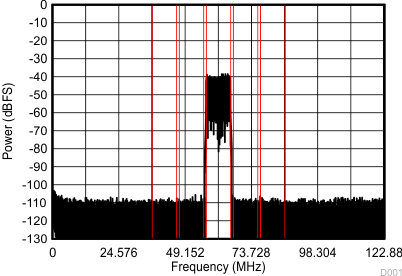
| Ref. Power = –11.98 dFBS | Lower Adj. = 69.92 dBc | Lower Alt. = 70.28 dBc |
| Upper Adj. = 69.92 dBc | Upper Alt. = 70.17 dBc |
